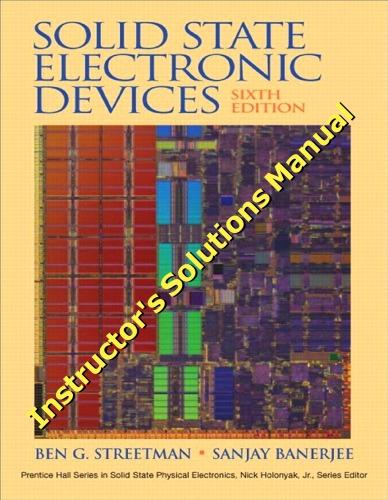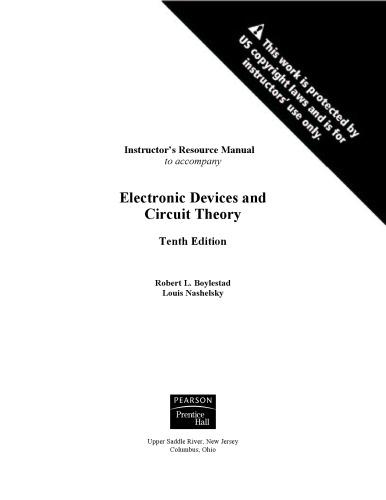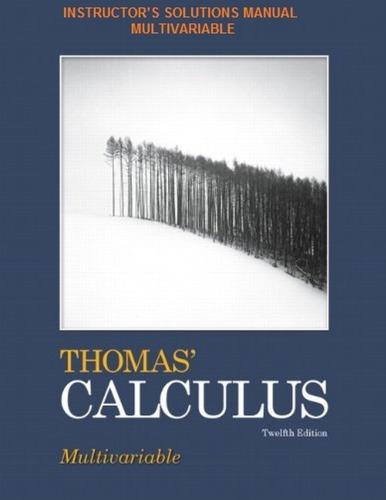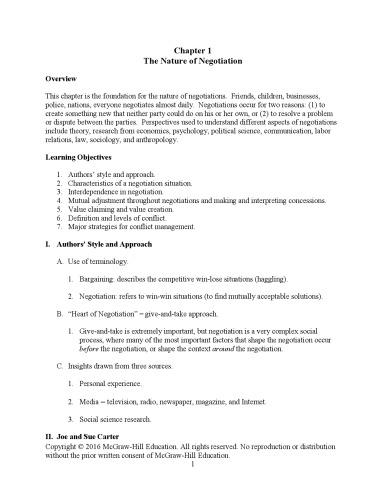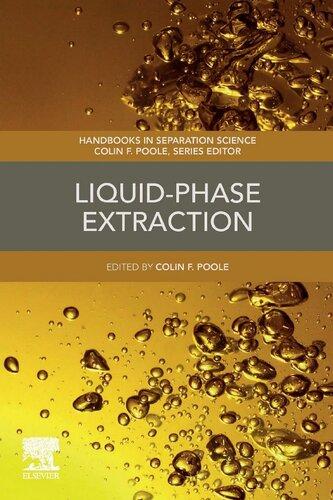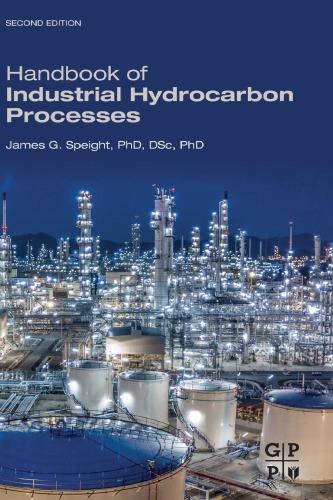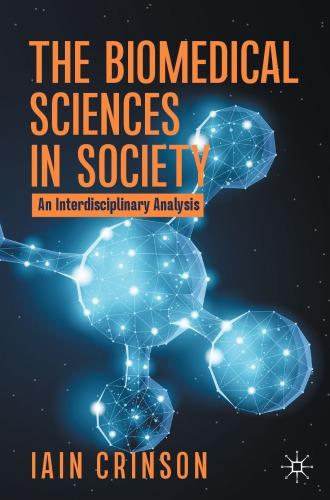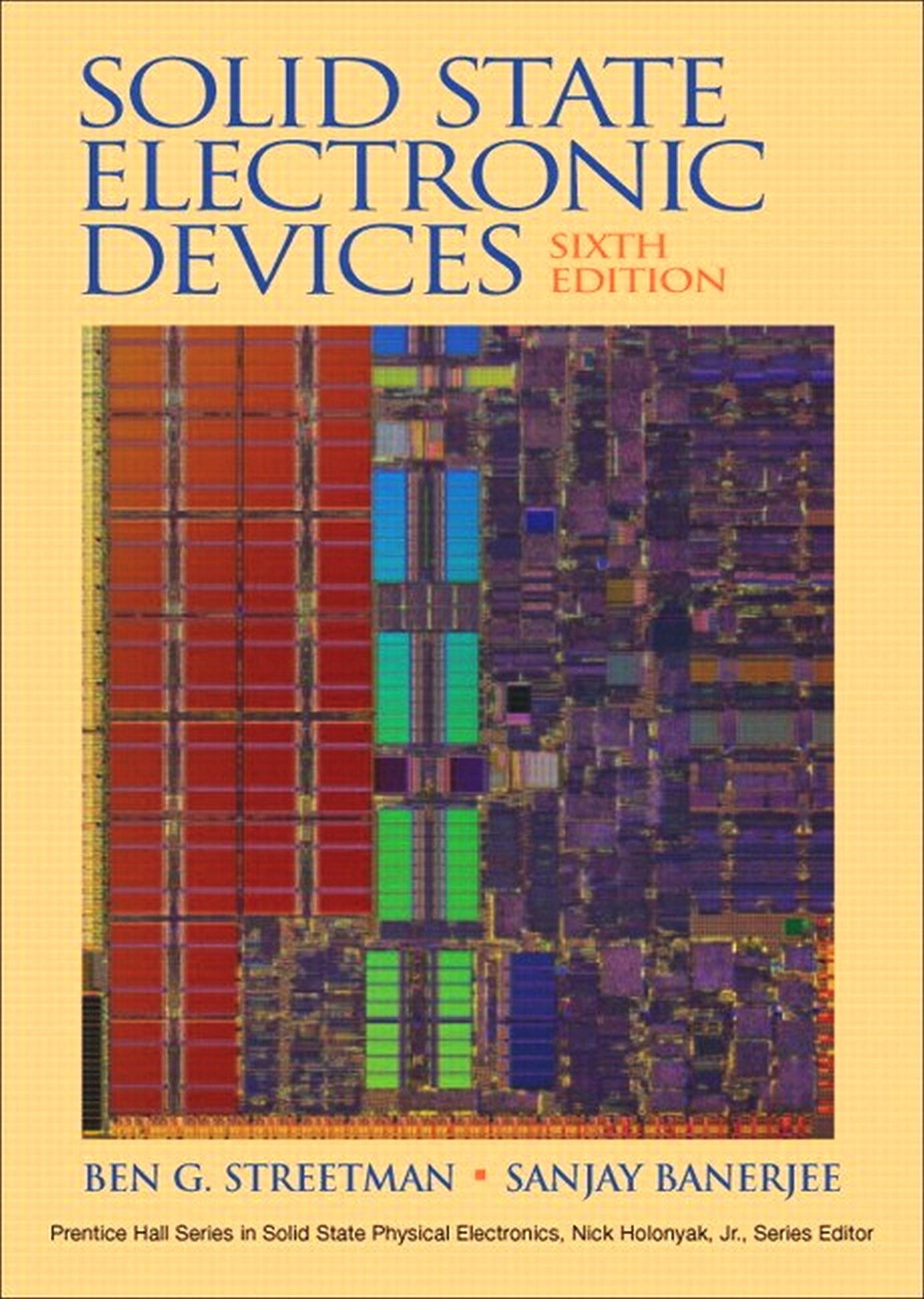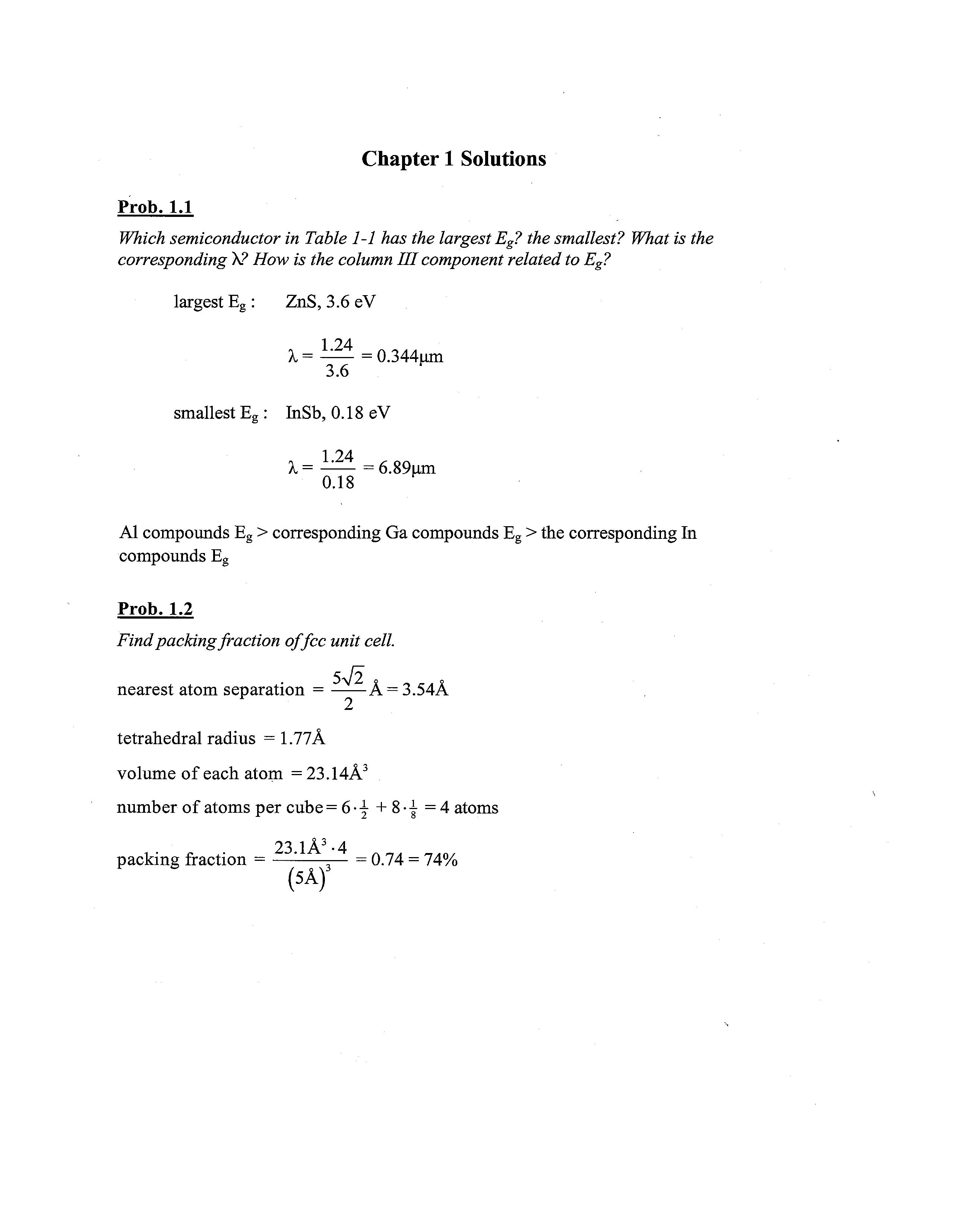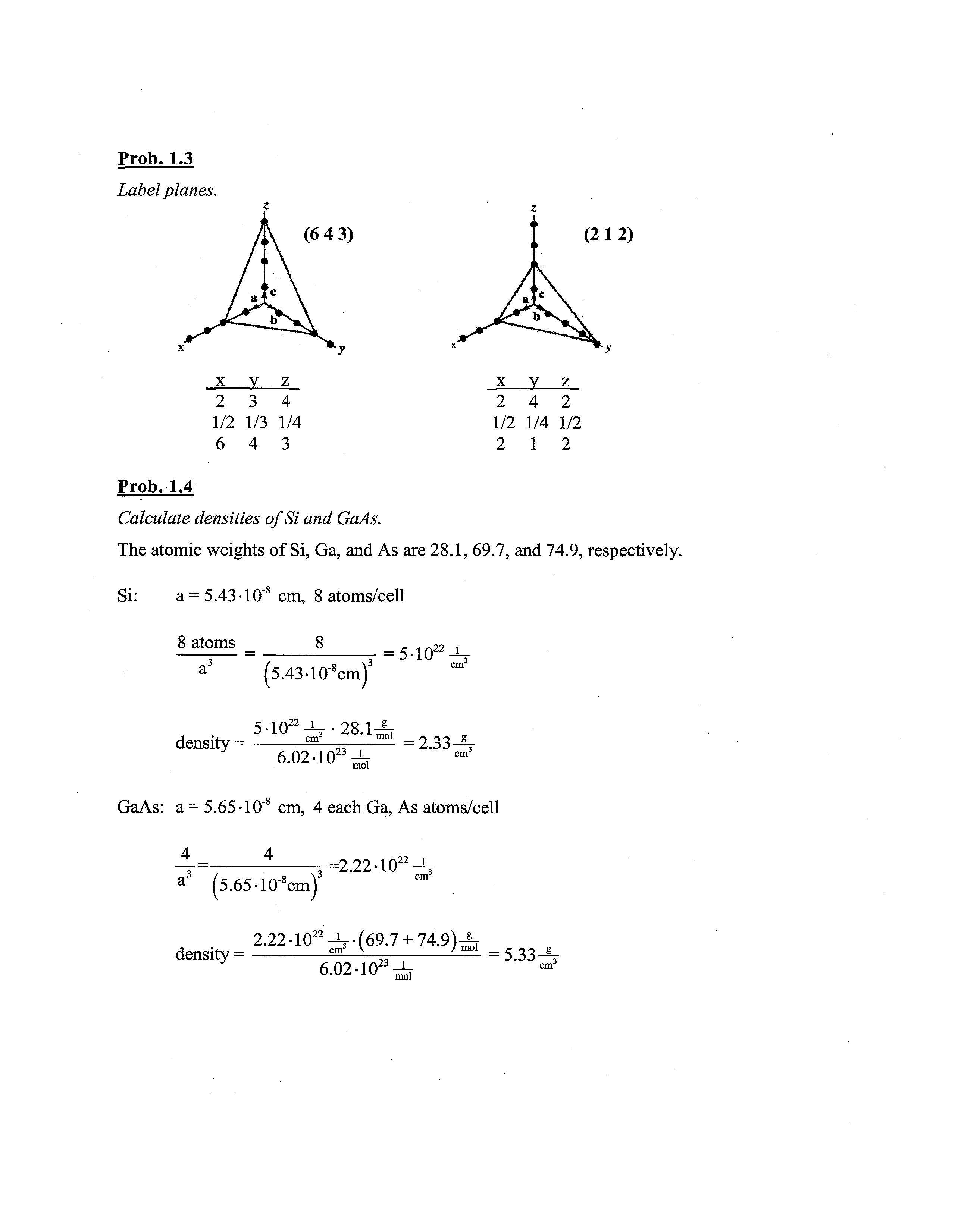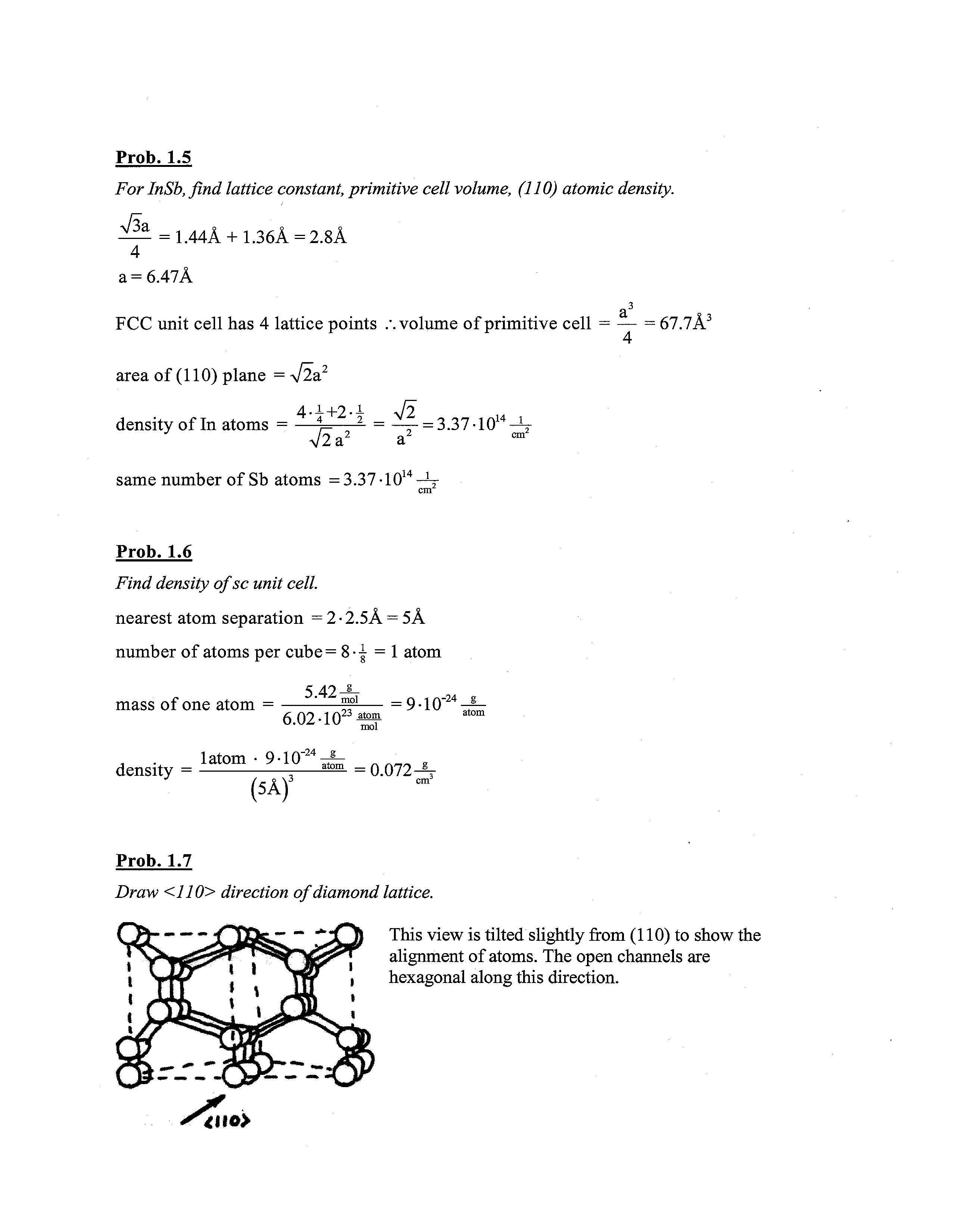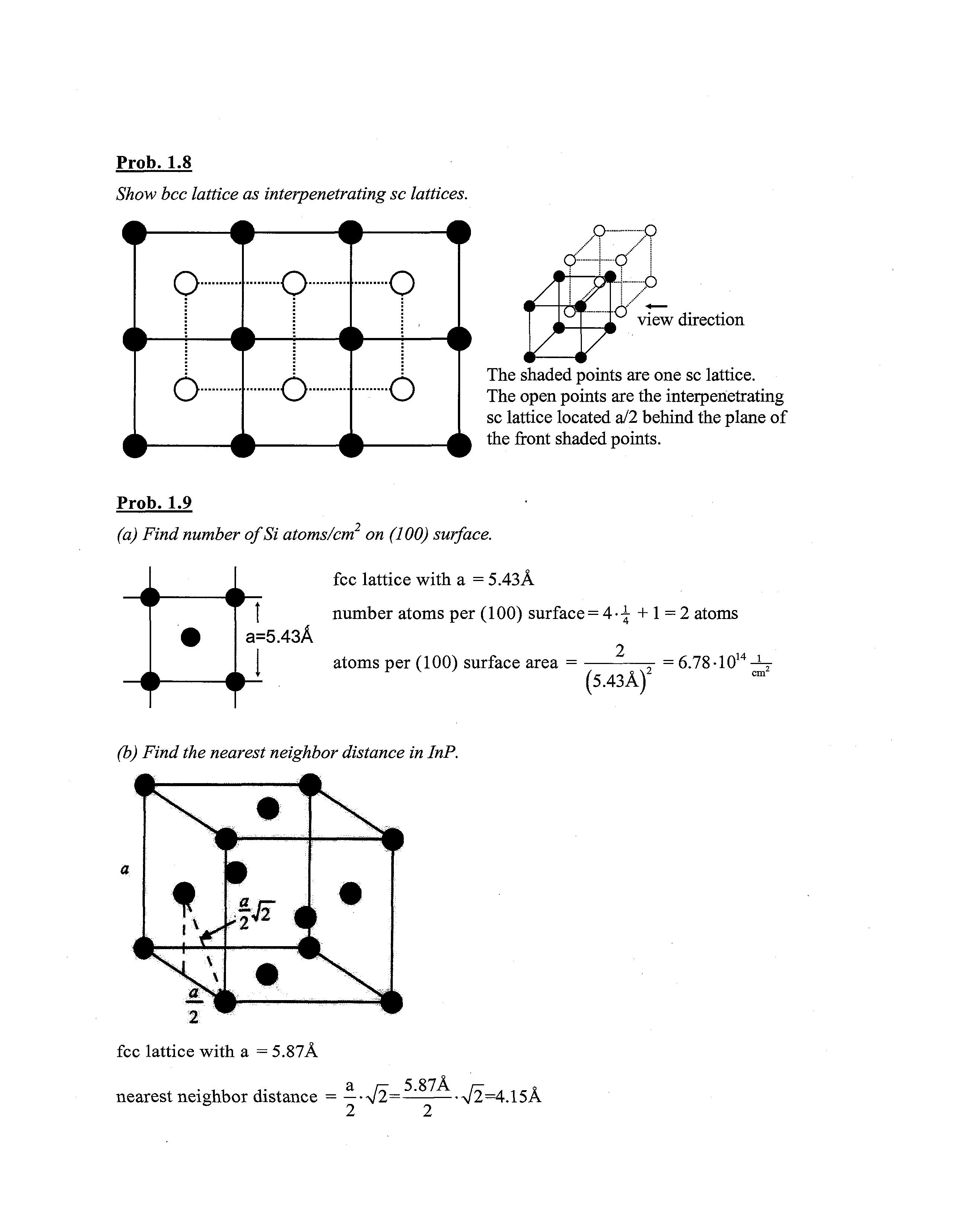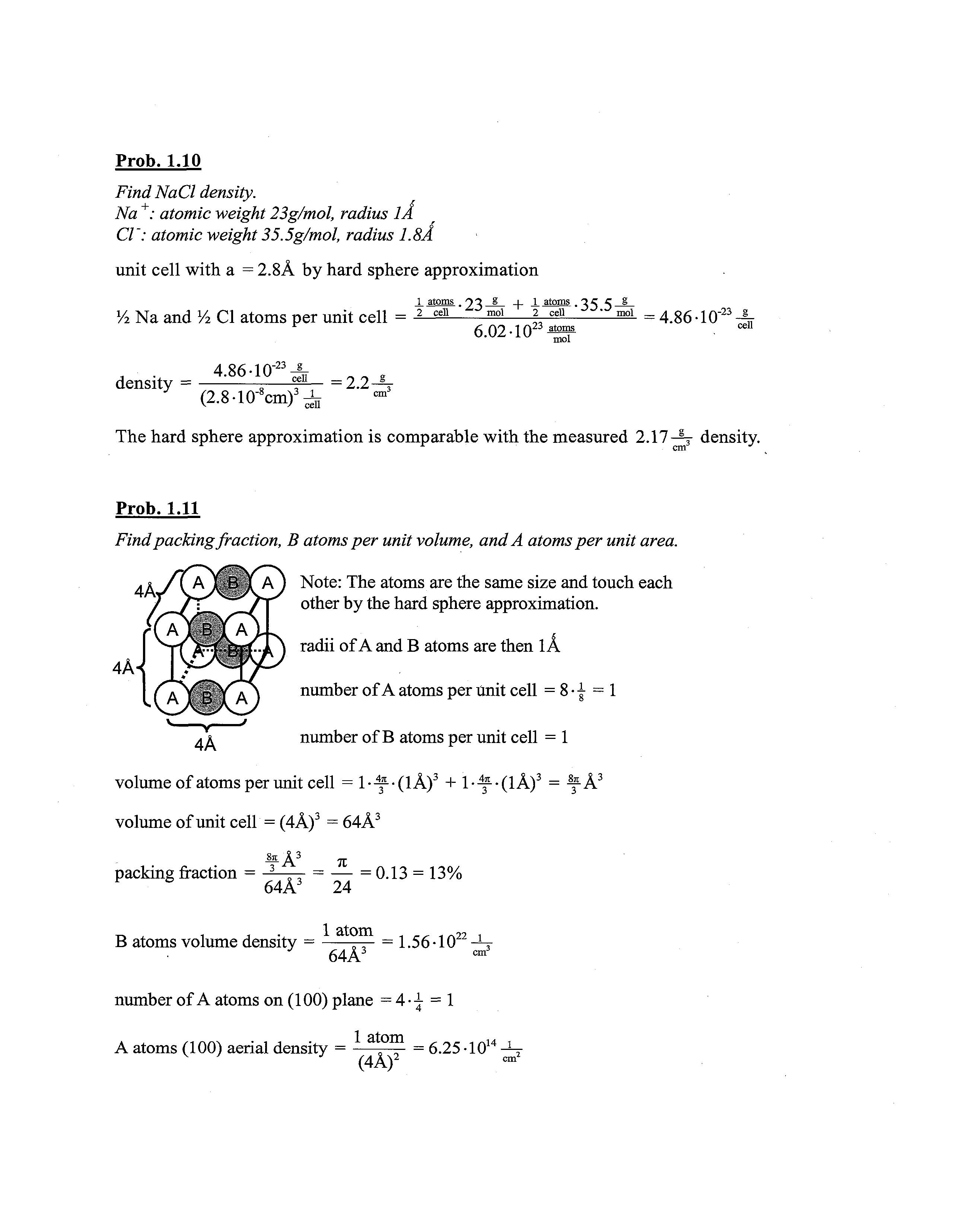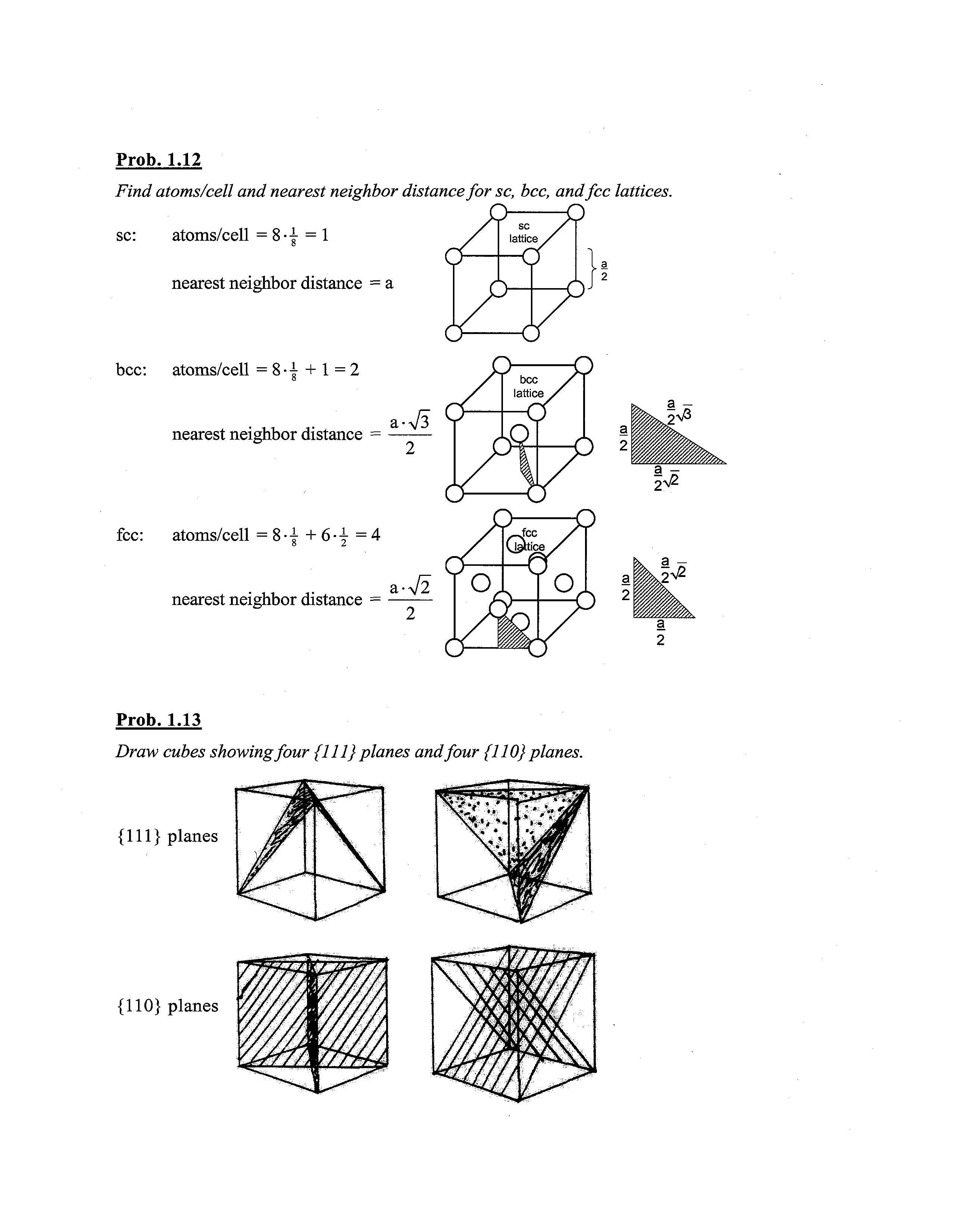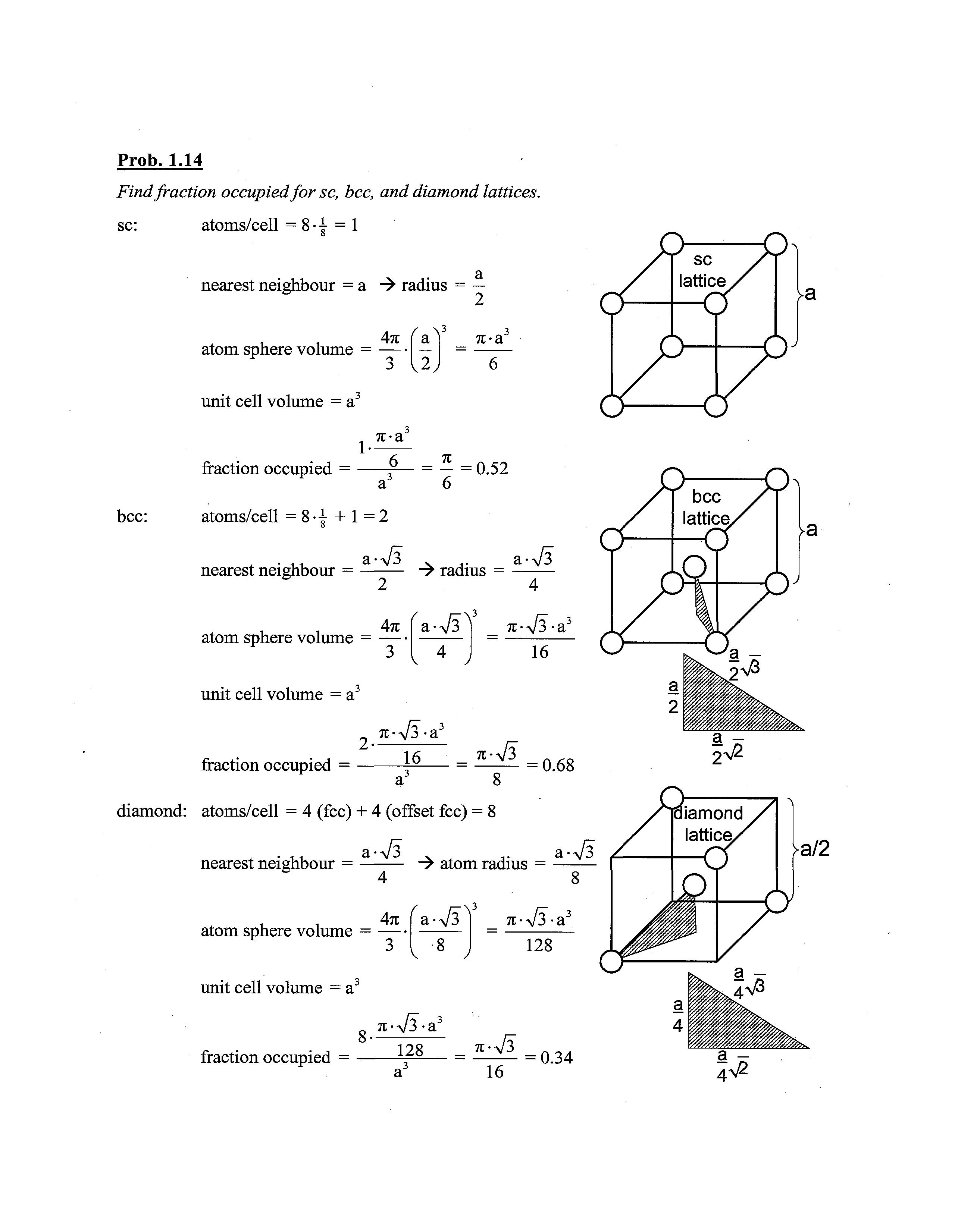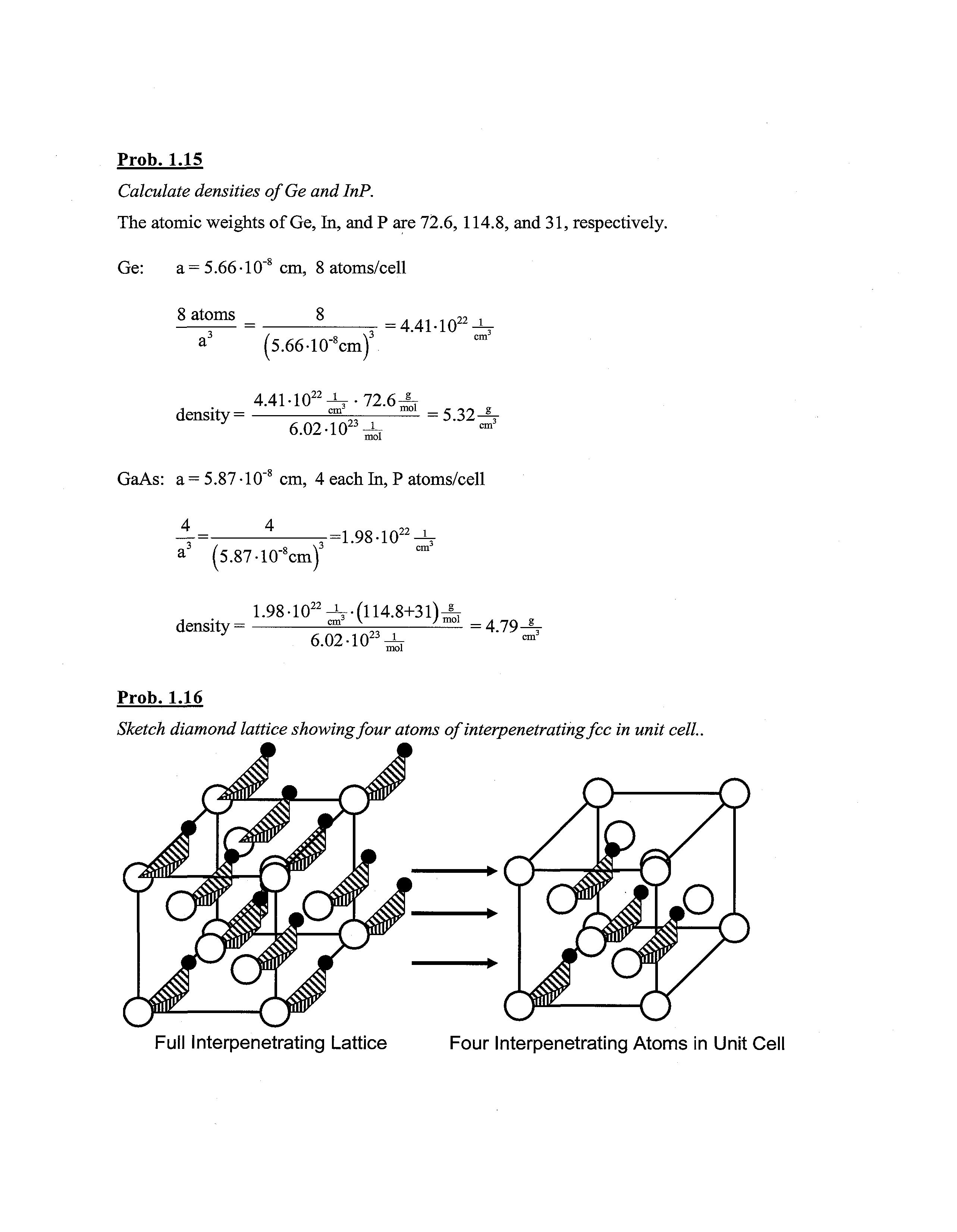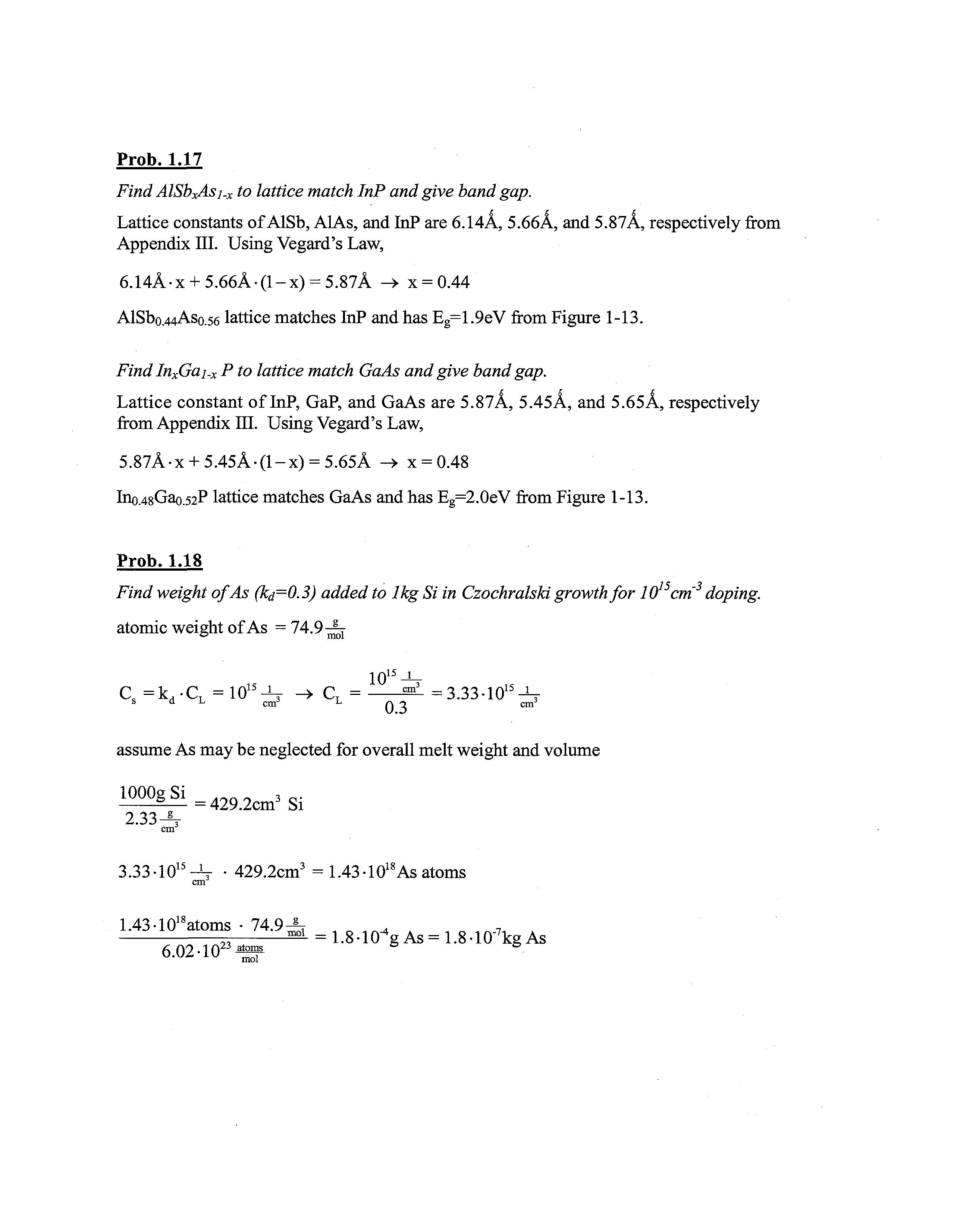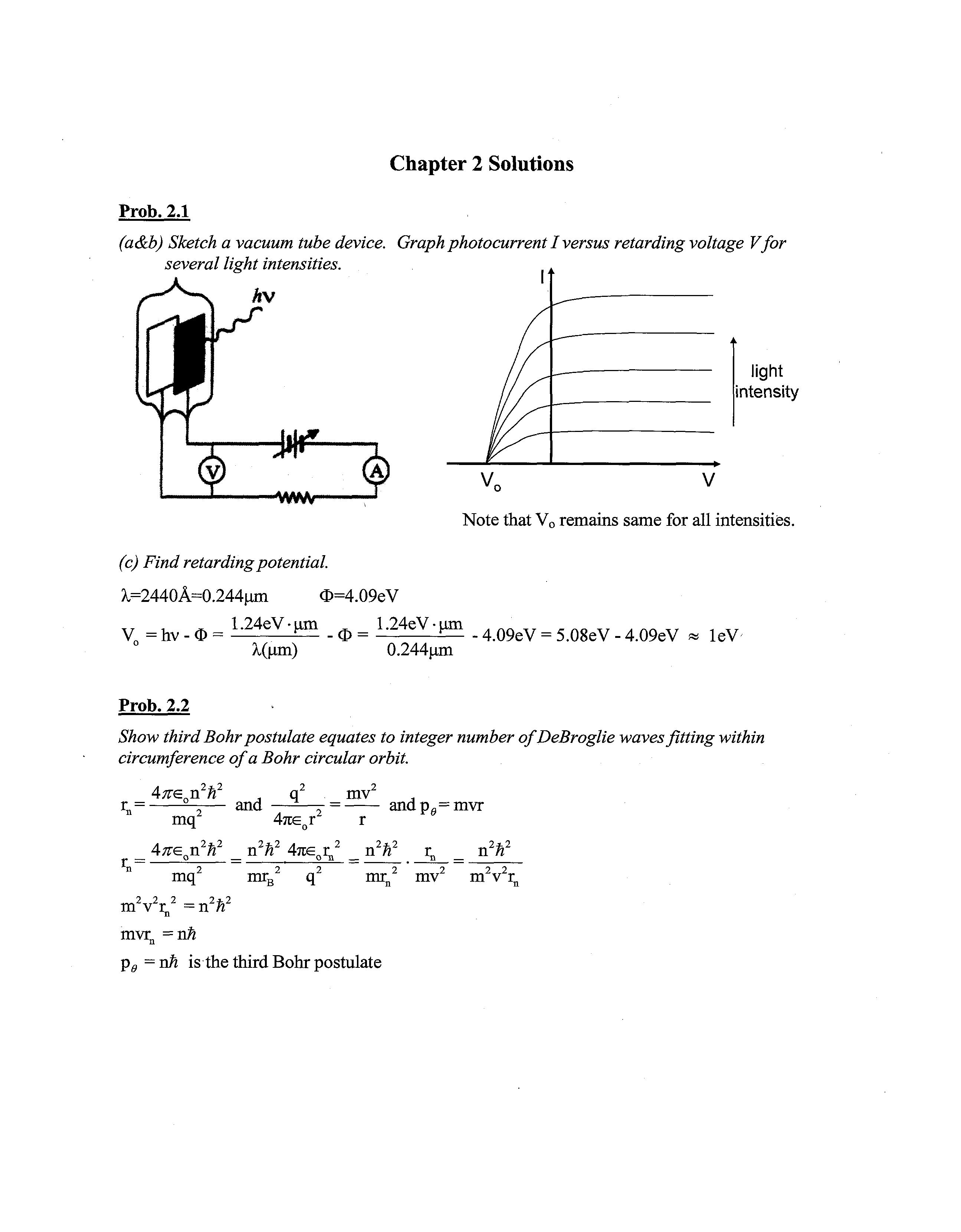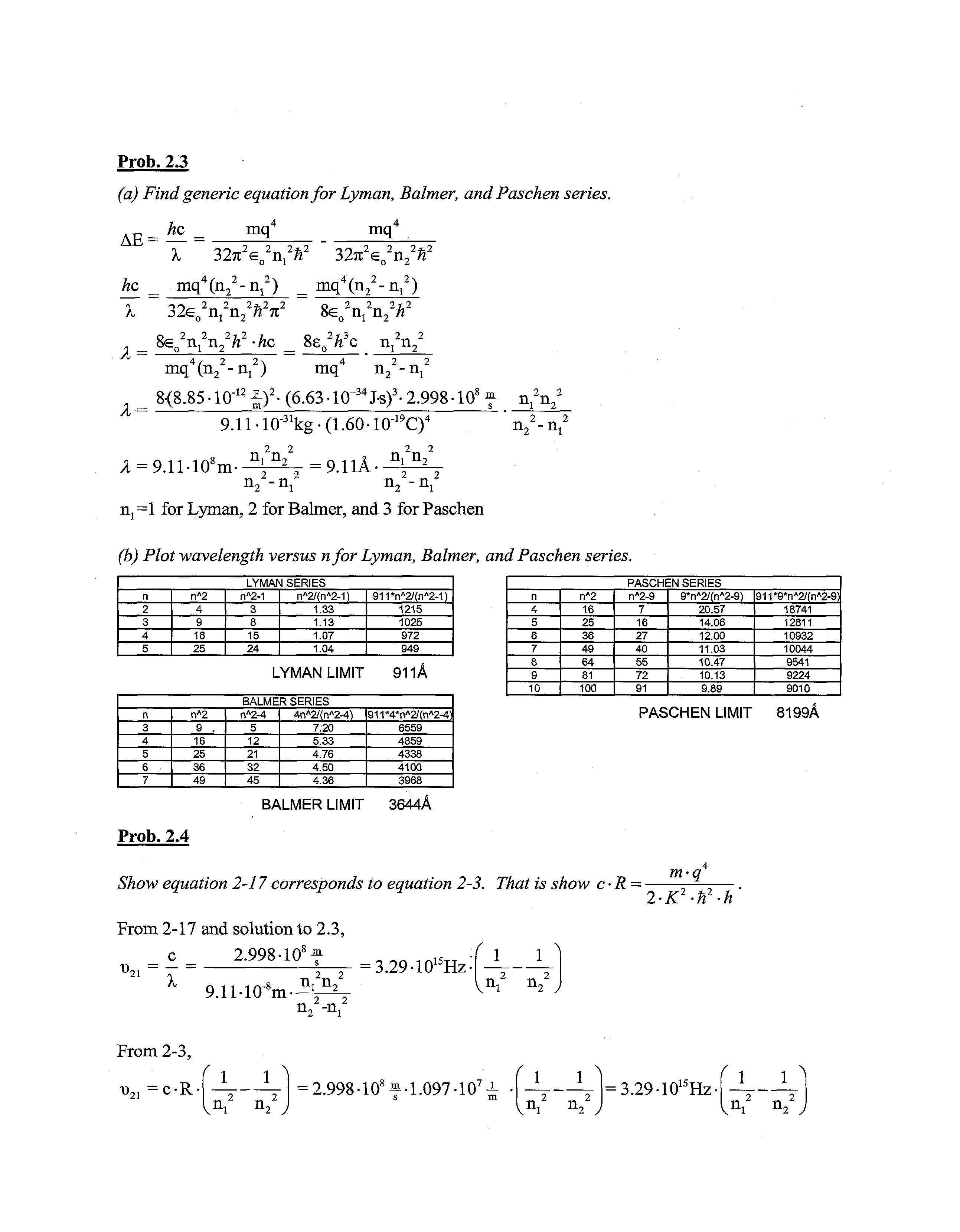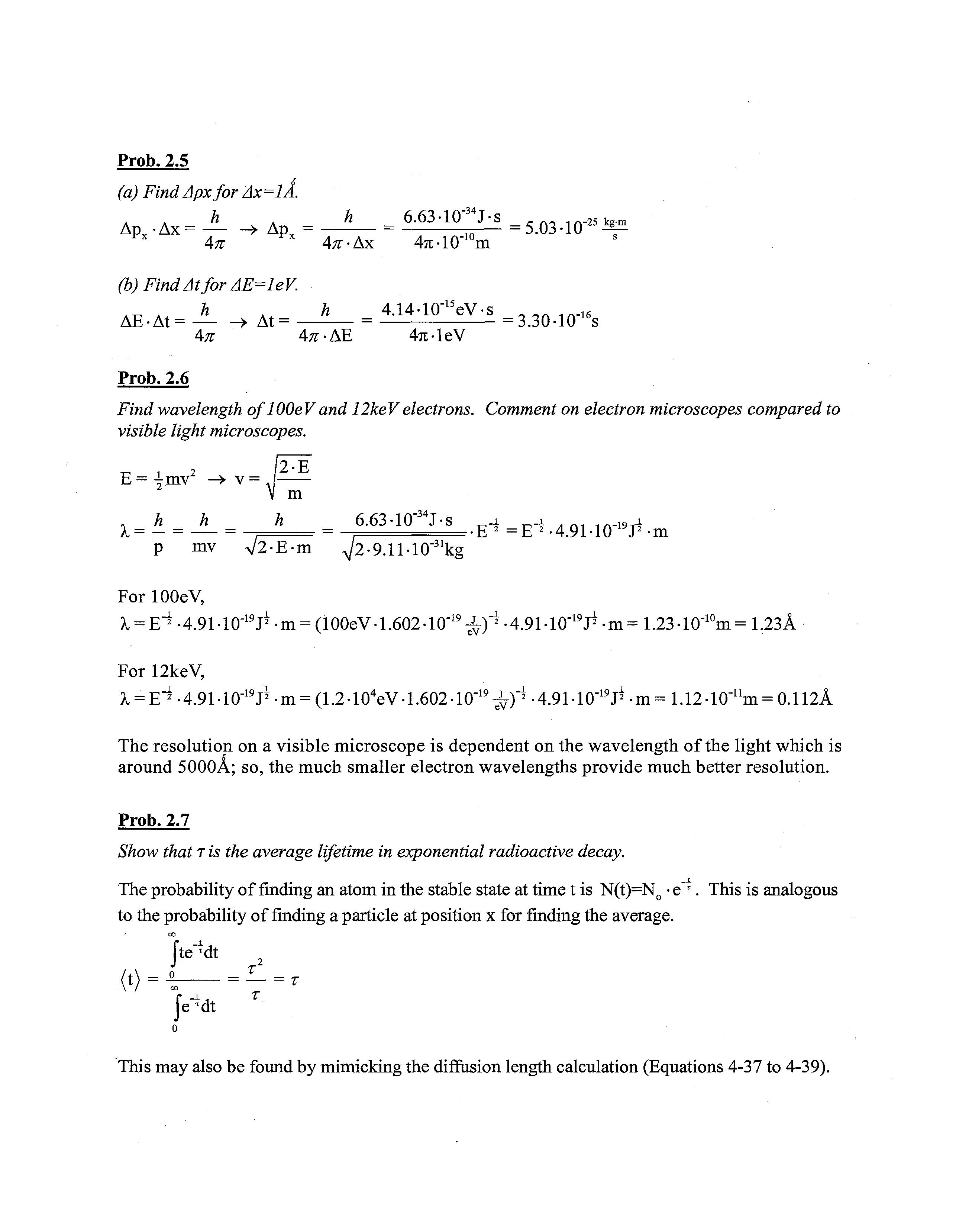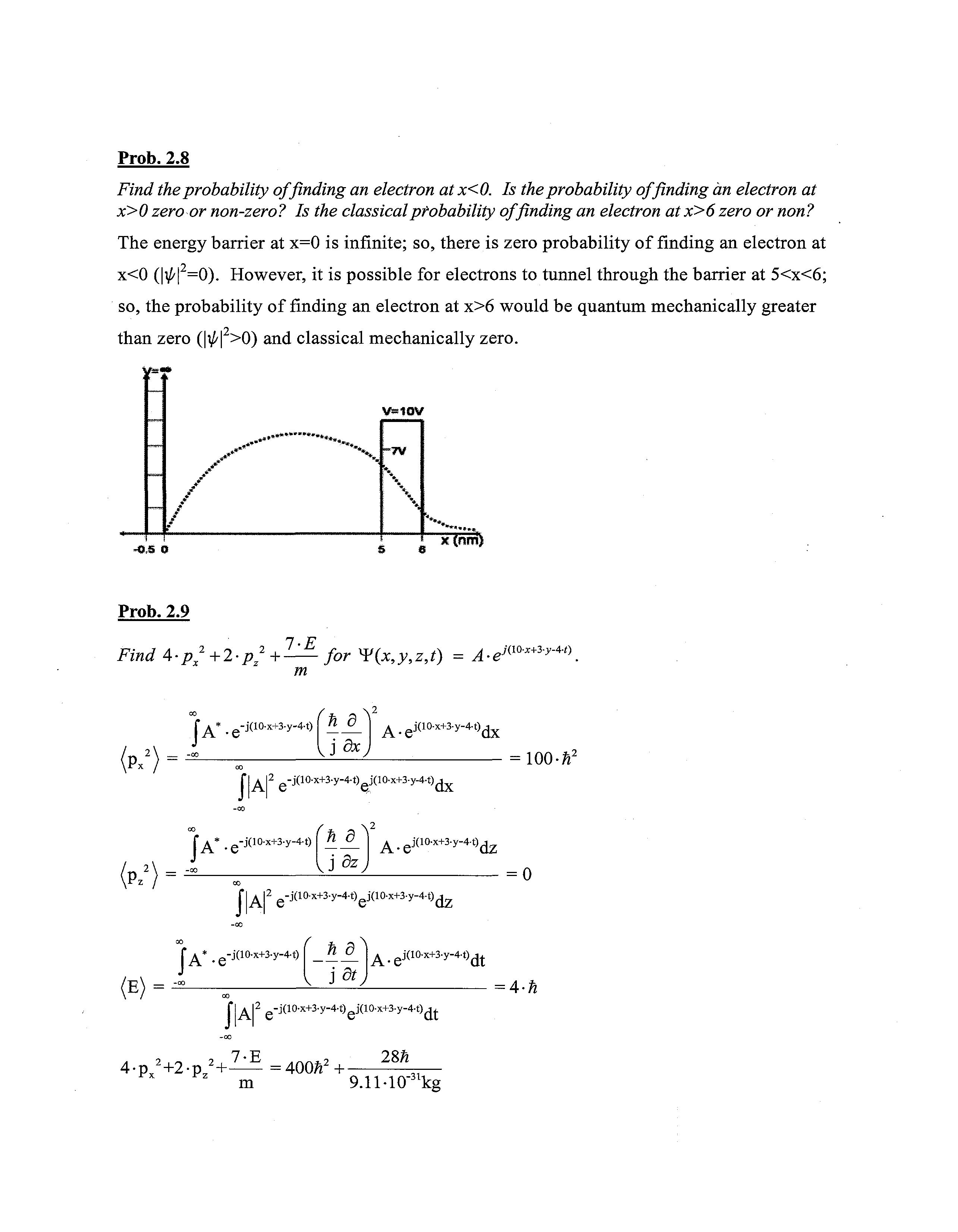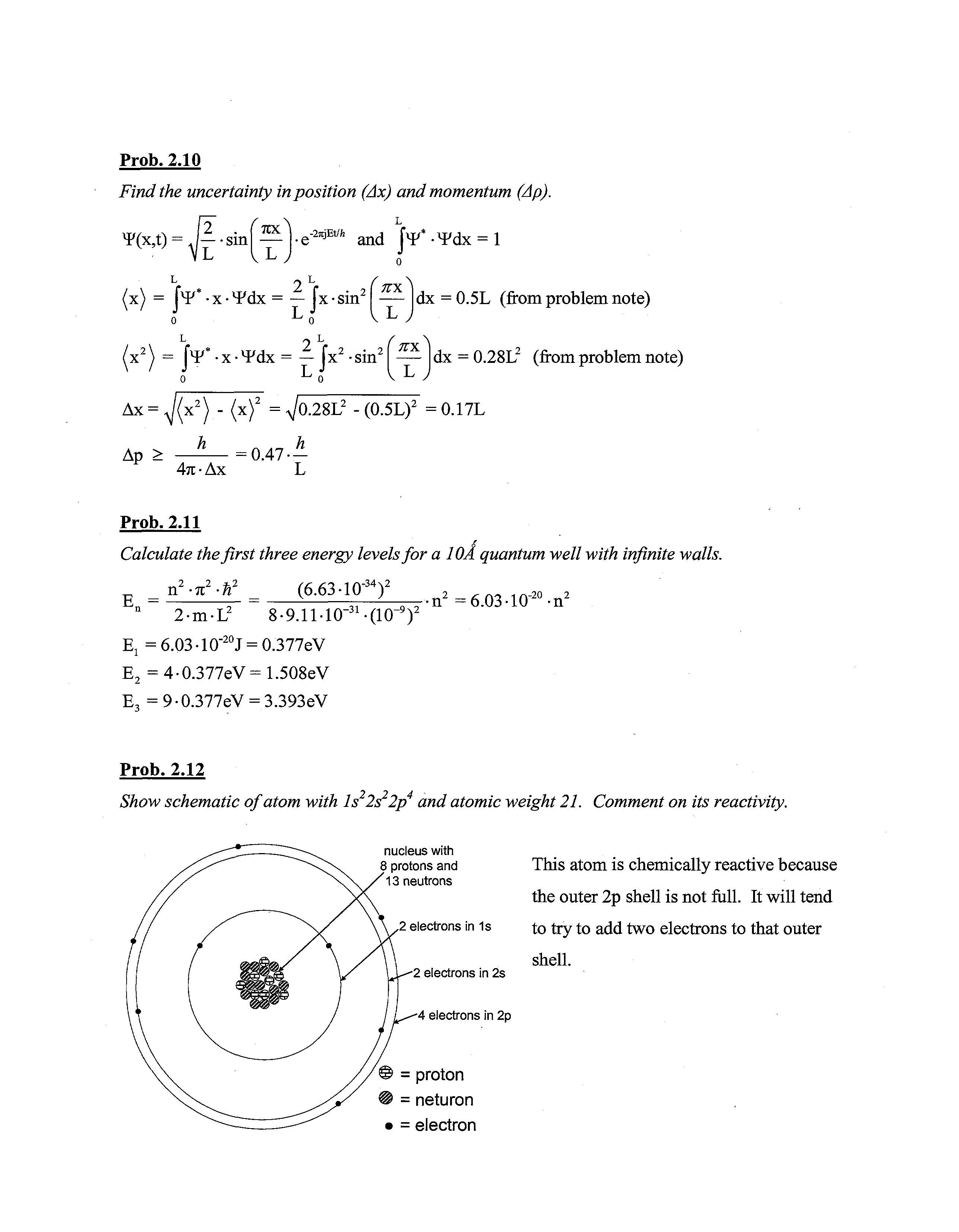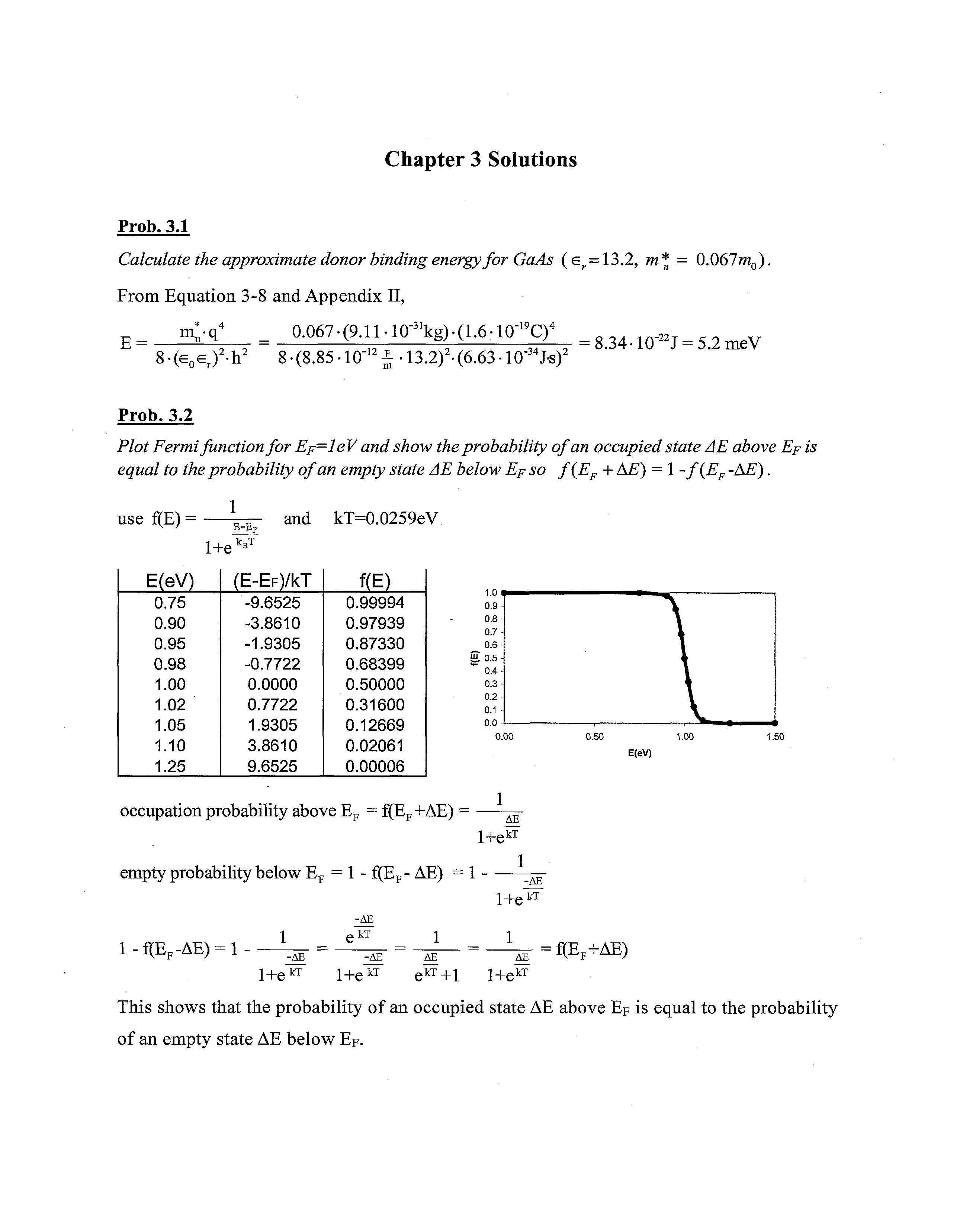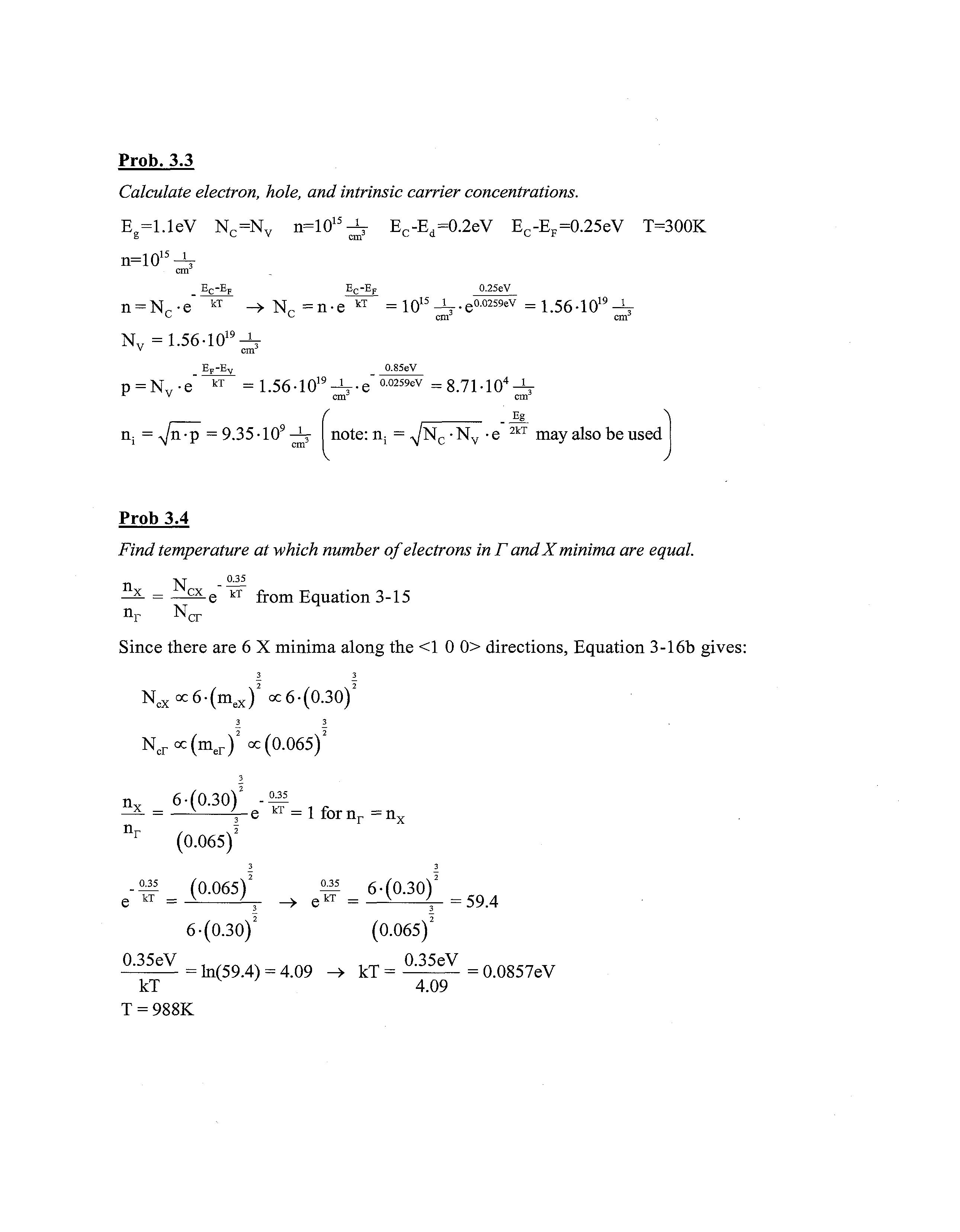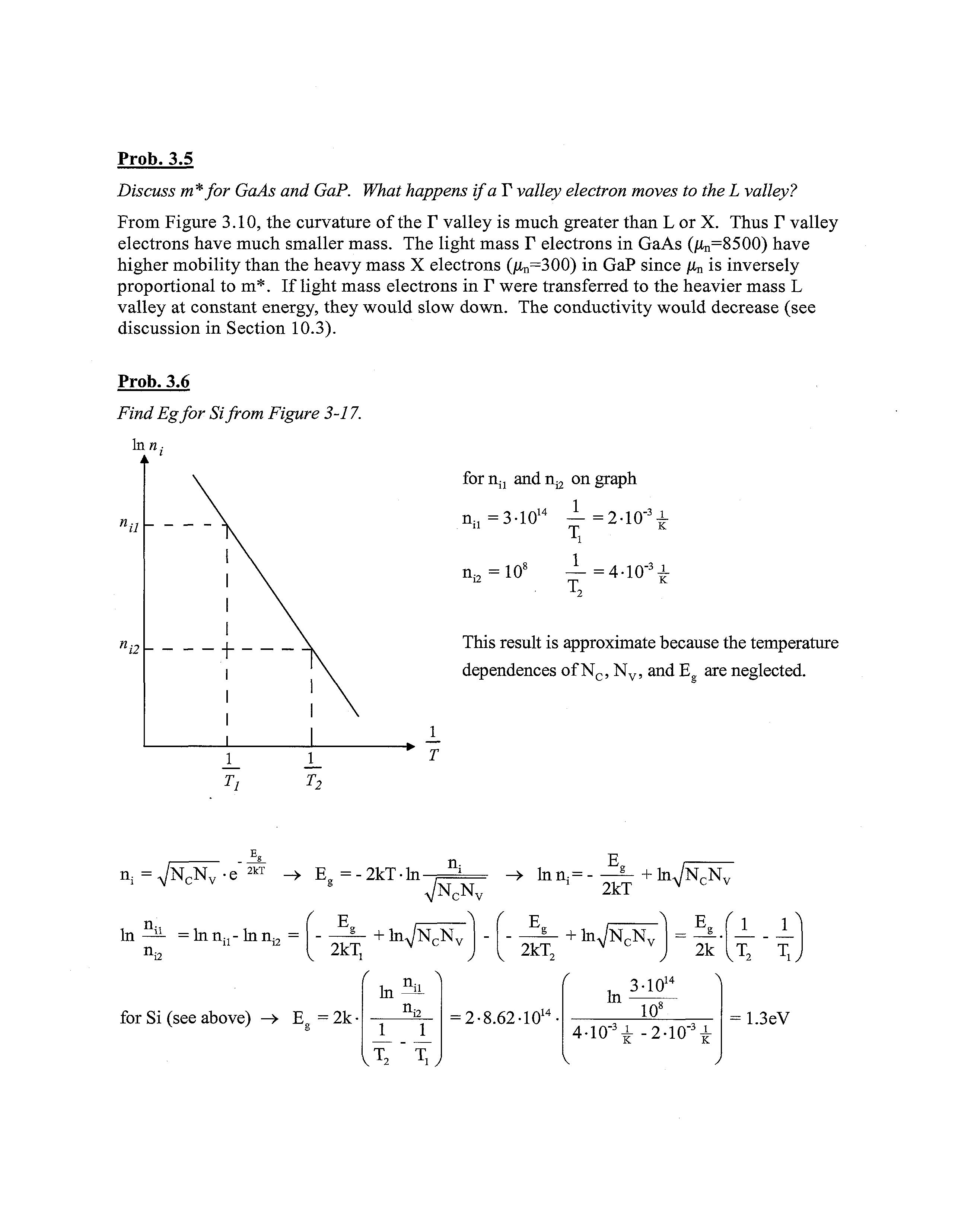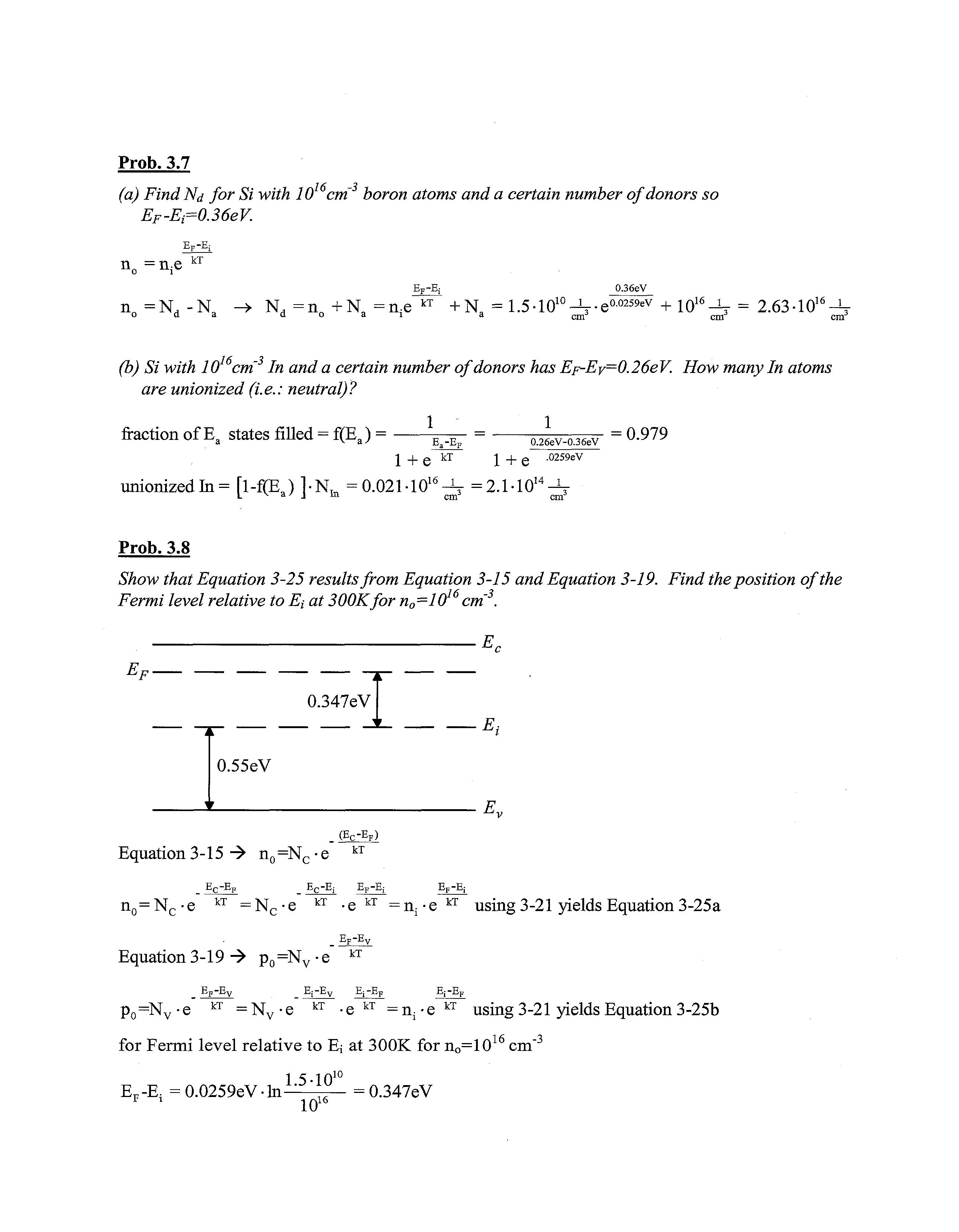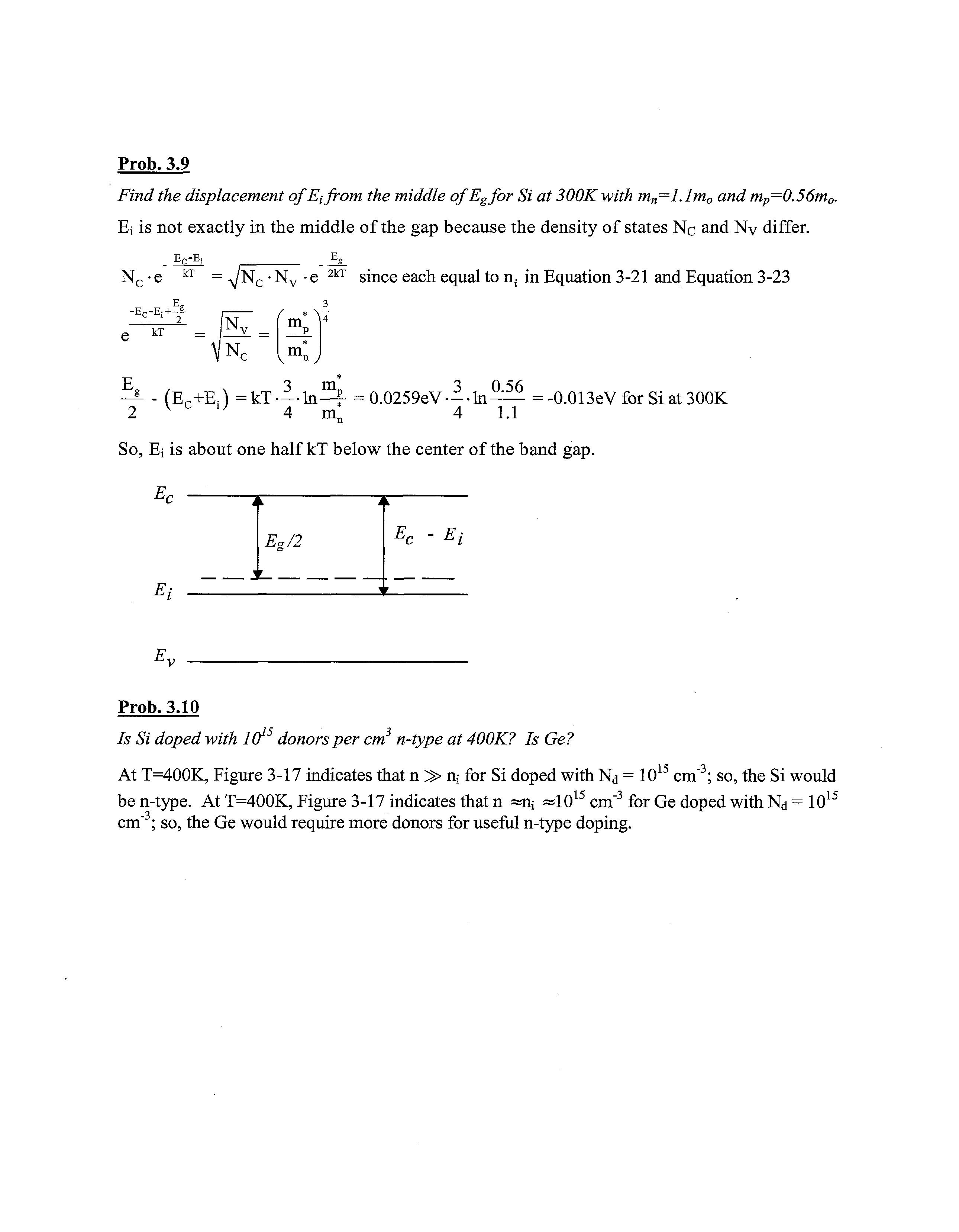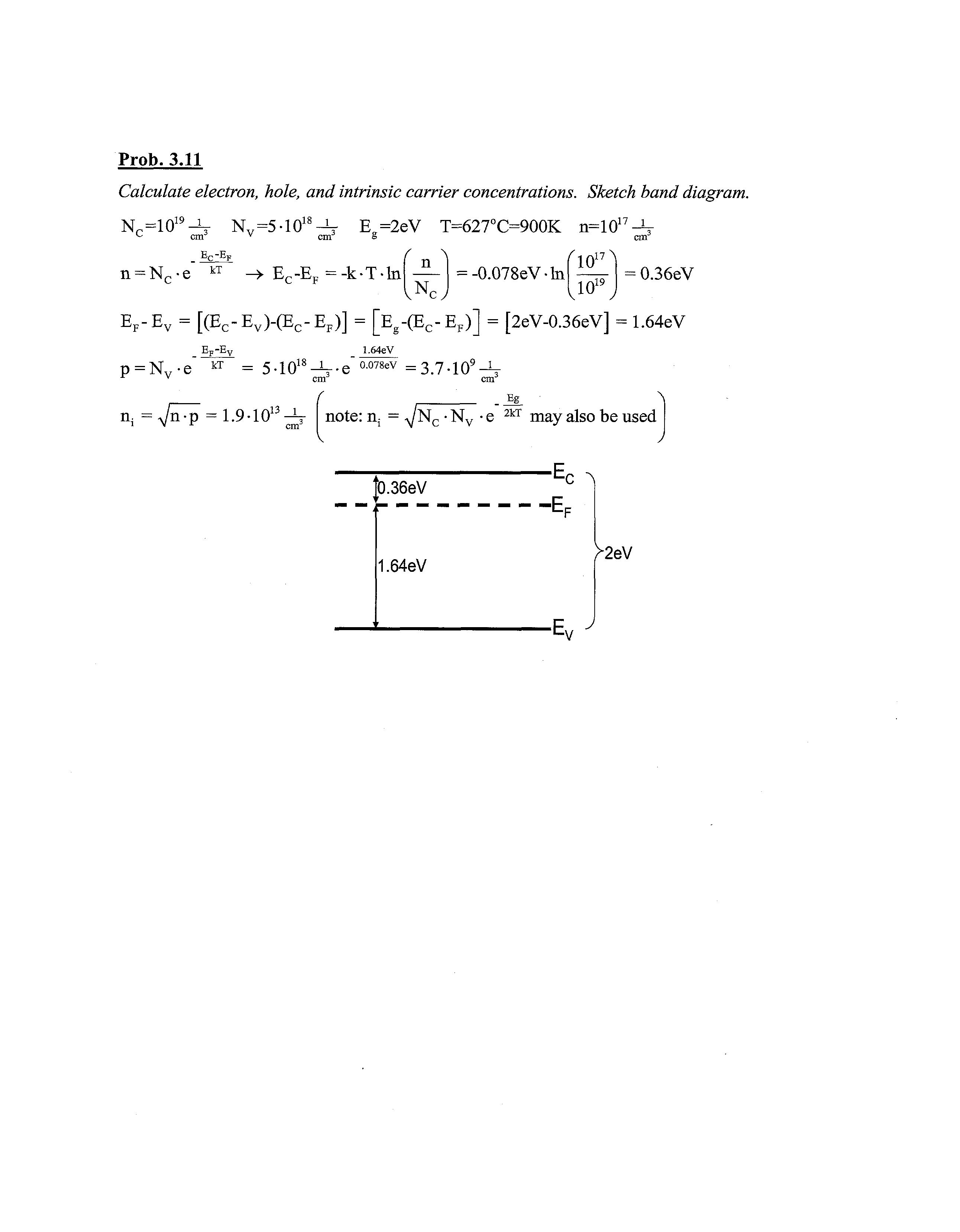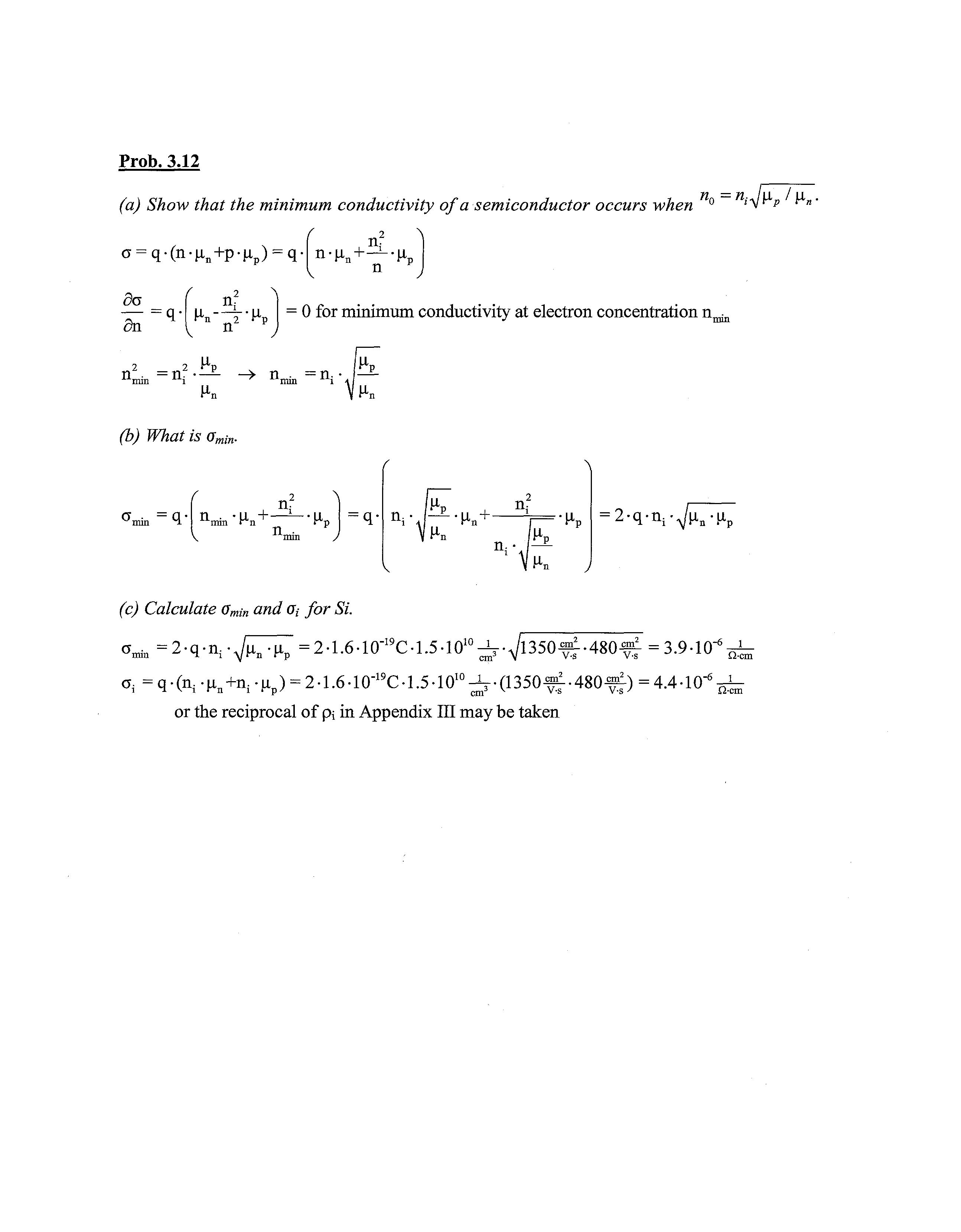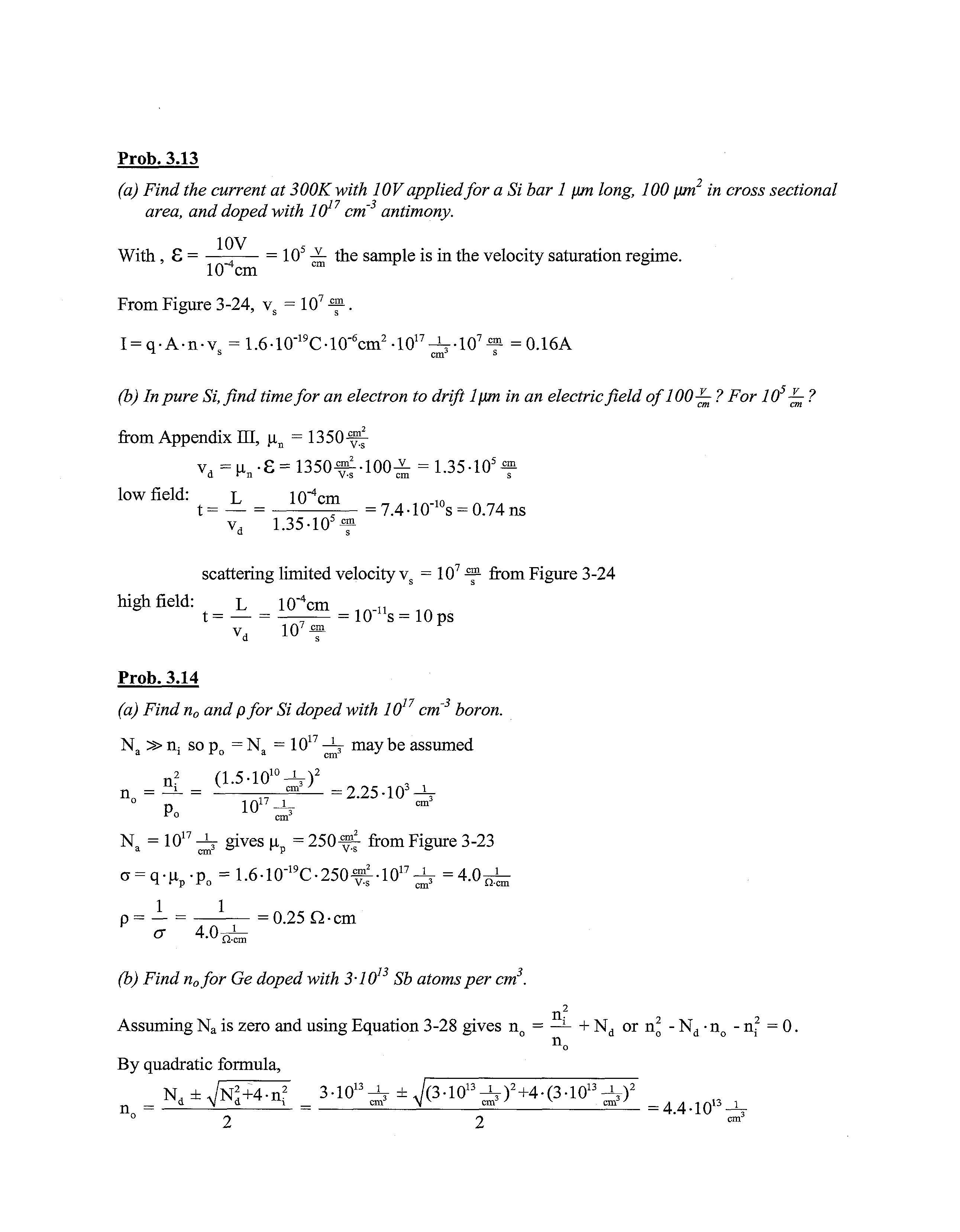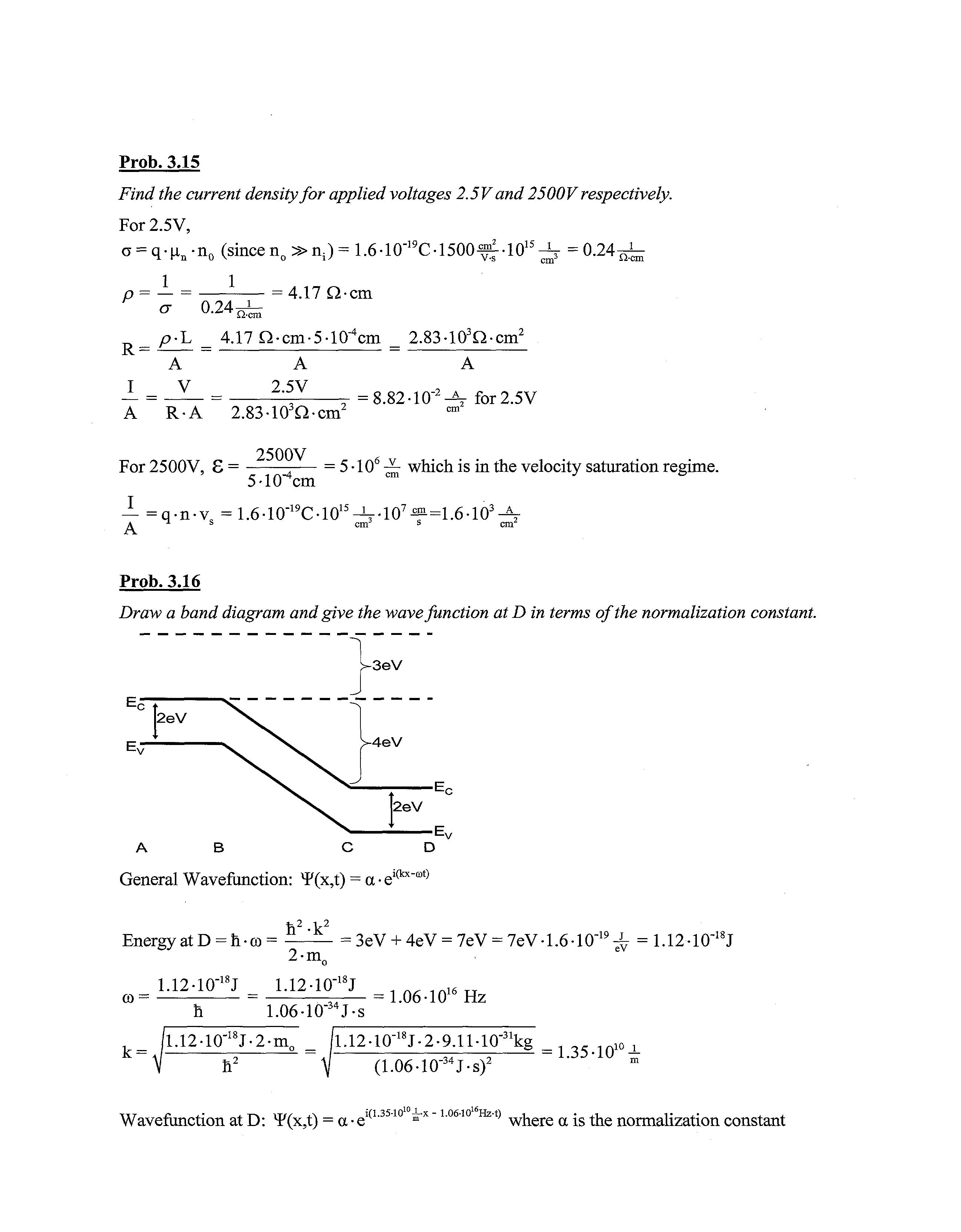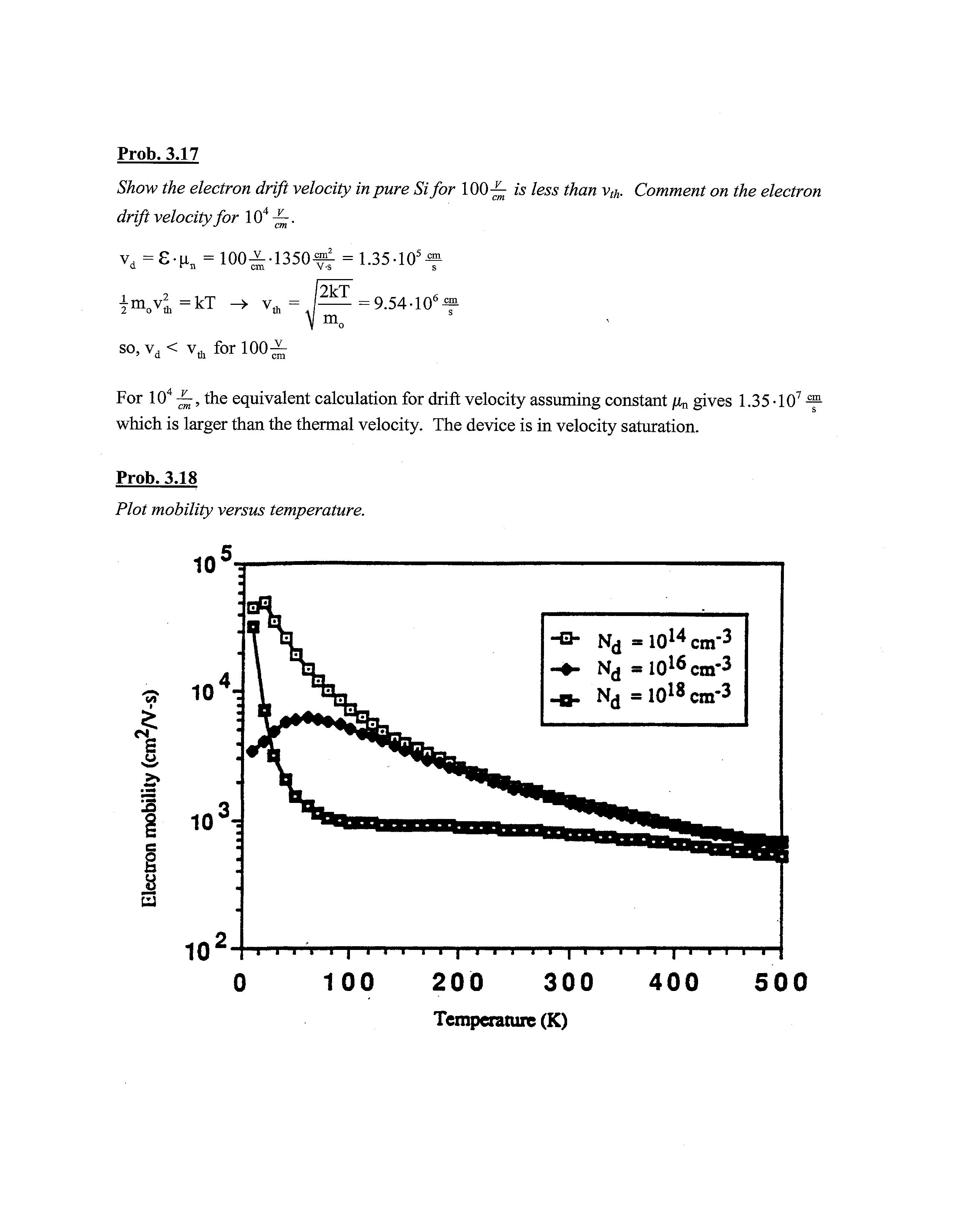Chapter 1 Solutions
Prob. 1.1
Which semiconductor in Table 1-1 has the largest Eg? the smallest? What is the corresponding A? How is the column III component related to Eg?
largest Eg : ZnS, 3.6 eV
1 24 X = ^=- = 0.344um 3.6
smallest Eg : InSb, 0.18 eV
1 24 1=^=^- = 6.89um 0.18
Al compounds Eg > corresponding Ga compounds Eg > the corresponding In compounds Eg
Prob. 1.2
Find packing fraction offee unit cell. 5-\/2
nearest atom separation = A = 3.54A
tetrahedral radius = 1.77A
volume of each atom =23.14A3
number of atoms per cube =6--5- + 8•| =4 atoms
23 lA3 -4 packing fraction = — '; = 0.74 = 74% (5A)3
Prob. 1.3
Label planes. (6 4 3) x y z 2 3 4 1/2 1/3 1/4 6 4 3
Prob. 1.4
(212) x y z 2 4 2 1/2 1/4 1/2 2 1 2
Calculate densities of Si and GaAs. The atomic weights of Si, Ga, and As are 28.1, 69.7, and 74.9, respectively.
Si: a = 5.43-10"8 cm, 8 atoms/cell 8 atoms (5.43-10"8cm) 3 5-1022^ 3 cm density = 5-1022-L -28.1^ 6.02-1023 1 mol = 2.33-¾
GaAs: a = 5.65 -10"8 cm, 4 each Ga, As atoms/cell (5.65-10'scm) -=2.22-1022^ density = 2.22-1022 -V(69.7 + 74.9) cnr V / mol 6.02-1023 1 mol = 5.33 A
Prob. 1.5
For InSb, find lattice constant, primitive cell volume, (110) atomic density.
^=1.44 A + 1.36A = 2.8A 4
a=6.47A a 3
FCC unit cell has 4 lattice points /.volume of primitive cell = — = 61.lK?
area of (110) plane = V2a2
4.1+2.1 ^/2
density of In atoms = —%= - = -^- = 3.37-1014^ V2a2 a 2
same number of Sb atoms = 3.37-1014 1 cm
Prob. 1.6
Find density ofsc unit cell.
nearest atom separation = 2 • 2.5A = 5A
number of atoms per cube= 8 •| = 1 atom
5 42-^mass of one atom = :—^ = 9-10~24-§6.02-10 ^ f
density = **™ ' ^i& r = QQ (5A)3
Prob. 1.7
Draw <110> direction of diamond lattice.
This view is tilted slightly from (110) to show the Y alignment of atoms The open channels are 1 hexagonal along this direction
Prob. 1.8
Show bcc lattice as interpenetrating sc lattices.
view direction
The shaded points are one sc lattice The open points are the interpenetrating sc lattice located a/2 behind the plane of the front shaded points.
Prob. 1.9
(a) Find number of Si atoms/cm on (100) surface.
fee lattice with a = 5.43A
number atoms per (100) surface = 4-| + 1 = 2 atoms 2 I a=5.43A I atoms per (100) surface area , - =6.78-1014^ (5.43A)2
(b) Find the nearest neighbor distance in InP.
fee lattice with a = 5.87A
nearest neighbor distance = *.^i!ZA.V2-4.15A
Prob. 1.10
Find NaCI density.
Na : atomic weight 23g/mol, radius
CI': atomic weight 35.5g/mol, radius 1.
unit cell with a = 2.8A by hard sphere approximation 1 atoms , Qg g _| 1 atoms gg g g
Vi Na and lA CI atoms per unit cell =2 ^ ^ ^ '-^ = 4.86 -10"23 -\ 6.02-1023 ^gf ^
density = 4.86-1023^ =22^_ (2.8-10-^) 3 ^
The hard sphere approximation is comparable with the measured 2.17-^ density.
Prob. 1.11
Find packing fraction, B atomsper unit volume, and A atomsper unit area.
AhJ Vrt A D A rt ) Note: The atoms are the same size and touch each other by the hard sphere approximation. radii ofA and B atoms are then lA number ofA atoms per unit cell = 8• \ = 1 4A number of B atoms per unit cell = 1 volume of atoms per unit cell = l-^-(lA)3 + l-^-(lA)3 = f^A3
volume of unit cell = (4A)3 = 64A3 MA3 71 packing fraction = 3 ., = — = 0.13 = 13% 64A3 24 B atoms volume density = ^- = 1.56-1022 ~ 64A3 number of A atoms on (100) plane = 4-1 = 1 A atoms (100) aerial density = 1 a ^° m = 6.25-1014 -½ (4A)2
Prob. 1.12
Find atoms/cell and nearest neighbor distancefor sc, bcc, andfee lattices.
sc: atoms/cell = 8-j = 1
nearest neighbor distance = a
bcc: atoms/cell =8-1 + 1=2
nearest neighbor distance = L->/3
fee: atoms/cell = 8-|+6-f=4
nearest neighbor distance = i-V2
Prob. 1.13
Draw cubes showingfour {111} planes andfour {110} planes. {111} planes {110} planes
Prob. 1.14
Findfraction occupiedfor sc, bcc, and diamond lattices.
sc: atoms/cell = 8-1 = 1
nearest neighbour = a -> radius = — 2
bcc: atom sphere volume = 4TE (-)3 \2) Tt-a
unit cell volume = a
nearest neighbour = -> radius = -
fraction occupied = j ^ = = 0.68 a 8
diamond: atoms/cell = 4 (fee) + 4 (offset fee) = 8
nearest neighbour = —: -> atom radius = atom sphere volume = 4
Prob. 1.15
Calculate densities ofGe andlnP.
The atomic weights of Ge, In, and P are 72.6,114.8, and 31, respectively.
Ge: a= 5.66-10"8 cm, 8 atoms/cell
8 atoms a (5.66-l(r8cm) = 4.41-1022 ^r density= 4.41-1022^-72.6-!mol 6.02-1023 _J_ mol = 5.32-^
GaAs: a = 5.87 -10~8 cm, 4 each In, P atoms/cell (5.87-10"8cm) -=1.98-1022 ^r
1.98-10^^-(114.8+31)-^ density = , "* \ „, J-^- =4.79^ 6-02-1023^
Prob. 1.16
Sketch diamond lattice showingfour atoms of interpenetratingfee in unit cell..
Prob. 1.17
FindAlSbxAsi-x to lattice match InP and give band gap.
Lattice constants ofAlSb, AlAs, and InP are 6.14k, 5.66k, and 5.87A, respectively from Appendix III. Using Vegard's Law,
6.14A-x + 5.66A-(l-x) = 5.87A -> x = 0.44
AlSbo.44Aso.56 lattice matches InP and has Eg=1.9eV from Figure 1-13.
Find InxGai-x P to lattice match GaAs and give band gap.
Lattice constant of InP, GaP, and GaAs are 5.87A, 5.45A, and 5.65A, respectively from Appendix IE Using Vegard's Law,
5.87A-x + 5.45A-(l-x) = 5.65A -> x = 0.48
Ino.48Gao.52P lattice matches GaAs and has Eg=2.0eV from Figure 1-13.
Prob. 1.18
Find weight of As (kd=0.3) added to lkg Si in Czochralski growthfor 1015cm'3 doping. atomic weight ofAs = 74.9^ 1015 -JC =kd -(^ = 10 15 ^ ->C L = ^- = 3.33-1015-½ assume As may be neglected for overall melt weight and volume
i°°2«® - 429.2cm' Si 2.33A cm
3.33-1015^ • 429.2cm3 = 1.43-1018As atoms cm
1.43-1018atoms • 74.9-^ mol 1 0 1 A-4„ A„- 1 0 1 A-7 6.02-1023^ = 1.8-10^g As = 1.8-10"'kg As
Chapter 2 Solutions
Prob. 2.1
(a&b) Sketch a vacuum tube device. Graphphotocurrent I versus retarding voltage Vfor several light intensities.
Note that V0 remains same for all intensities.
(c) Find retarding potential. X=2440A=0.244um O=4.09eV
Prob. 2.2
Show third Bohr postulate equates to integer number ofDeBroglie wavesfitting within circumference of a Bohr circular orbit.
mvrn =11¾
p&=nh is the third Bohr postulate
Prob. 2.3
(a) Find generic equationfor Lyman, Balmer, and Paschen series.
AE: Ac _ mq
nj=l for Lyman, 2 for Balmer, and 3 for Paschen
(b) Plot wavelength versus nfor Lyman, Balmer, and Paschen series.
Prob. 2.4
Show equation 2-17 corresponds to equation 2-3. That is show c-R = m-q 2-K2-h2-h
From 2-17 and solution to 2.3, c »21 = 2.998-10* f 9.11-10-8m-^4 n2 V = 3.29-1015Hz-' V n i n2 J
From 2-3, u. c-R v n i n = 2.998-108 ^ 1.097-107 J- • 2 J V n i n = 3.29-1015Hz2 J f V n i n2 J
Prob. 2.5
(a) Find Apxfor Ax=
Apx-Ax = A _ * Apx = _J_ = 6.63-10^J-s =5034() . 25 ^ Fx An x 4;r-Ax 471-10-1¾
(b)FindAtforAE=leV.
AT. * * A A 4.14-10"15eV-s 0 1A -i 6 AE-At = -> At= = =3.30-10 16 s An An-AE 4jr-leV
Prob. 2.6
Find wavelength of WOeVand 12keVelectrons. Comment on electron microscopes compared to visible light microscopes.
E=imv 2 -> v=J — V m
X- * = ± = _ * = 6.63-lQ-J.s .E-* =E^4.9 1 .10-¥.m p mv V2-E-m ^/2-9.11-10-¾
For lOOeV, X = E_i-4.91-10"19P-m = (1OOeV-1.602-10-19^)4-4.91-10"19P-m=l.23-10-10 m =1.231
For 12keV, X = E^-4.91-10"19Ji -m = (1.2-104eV-1.602-10'19^)"i-4.91-10-19P-m=1.12-10"11 m = 0.112A
The resolution on a visible microscope is dependent on the wavelength of the light which is around 5000A; so, the much smaller electron wavelengths provide much better resolution.
Prob. 2.7
Show that T is the average lifetime in exponential radioactive decay.
The probability of finding an atom in the stable state at time t is N(t)=N0 •e"7 This is analogous to the probability of finding a particle at position x for finding the average.
t) = ^Jte'Mt 2T X Je'dt
This may also be found by mimicking the diffusion length calculation (Equations 4-37 to 4-39)
Prob. 2.8
Find the probability of finding an electron at x<0. Is the probability of finding an electron at x>0 zero or non-zero? Is the classical ptobability of finding an electron at x>6 zero or non?
The energy barrier at x=0 is infinite; so,there is zero probability of finding an electron at x<0 (|\b|2=0) However, it is possible for electrons to tunnel through thebarrier at 5<x<6; so, theprobability of finding an electron at x>6 would be quantum mechanically greater than zero (|^|2>0) and classical mechanically zero.
Prob. 2.9
Find 4-px 2+2-p2 2+—for W(x,y,z,t) = ^V 0 ^ ^ m
?h_dy v J faj
a-j(10-x+3-y-4-t) f hd^ jdt A-ej(10-x+3-y-4-t)dt v J •-"/ f|A|2e"j(10'x+3'y"4't)ei(10'x+3'y"4't)dt = 4-¾ 4-px 2+2-pz 2+ 7-E m • 400¾2 + 28¾ 9.11-10"31kg
Prob. 2.10
Find the uncertainty inposition (Ax) and momentum (Ap).
¥(x,t) =jl.sinf— \ Q -^ h and (f-fdx =l
(x2) = JV-x-^cb^-j x 0 dx = 0.5L (from problem note)
x) = JV-x-^Fdx^jx o L 0 L ~ L
2 (from problem note) Ax = ^(x2) - (x)2 = 70.28L2 - (0.5L)2 = 0.17L
=
Ap> -^=0.47- ^ 4TI-AX L
Prob. 2.11
Calculate the first three energy levelsfor a 10A quantum well with infinite walls. „ _ n 2-7i2^2 _ (6.63-10-34)2 ,-20 „ 2 2-m-L2 8-9.11-10-31 -(10-9)2
Ej = 6.03-10"20J = 0.377eV
E2=4-0.377eV=1.508eV
E3 = 9-0.377eV = 3.393eV •n 2 = 6.03-10" -n
Prob. 2.12
Show schematic of atom with Is 2s 2p and atomic weight 21. Comment on its reactivity.
nucleus with 8 protons and This atom is chemically reactive because 13 neutrons the outer 2p shell is not full It will tend
2 electrons in 1s to try to add two electrons to that outer shell.
2 electrons in 2s
4 electrons in 2p © = proton = neturon = electron
Chapter 3 Solutions
Prob. 3.1
Calculate the approximate donor binding energyfor GaAs (er = 13.2, m* = 0.067 m0).
From Equation 3-8 and Appendix II,
Prob. 3.2
Plot Fermifunction for Ep—leV and show theprobability of an occupied state AE above Ep is equal to theprobability of an empty state AE below Ep so f(EF + AE) = 1 -f(EF -AE). use f(E) = 1 1+e
This shows that the probability of an occupied state AE above Ep is equal to the probability of an empty state AE below EF
Prob. 3.3
Calculate electron, hole, and intrinsic carrier concentrations. ,„ _,„ ,-,=m 15J _
Eg=l.leV NC=NV n=1015^ - Ec-Ed=0.2eV Ec-EF=0.25eV T=300K
n=1015^
E r -E F E r -E F 0.25eV
n = N r -e kT ->N r =n-e k T = 10^-6^^=1.56-10 19 ^
Nv = 1.56-1019 ^r v cm EF-EV 0.85eV
p = Nv-e" kT =1.56-10^-^-6^-^^=8.71-10 4 ^ r v cm
nj = yn-p = 9.35-109^ note:n; = yjNc -Nv -e 2kT may also be used V
Prob 3.4
Find temperature at which number of electrons in T andX minima are equal.
9^1
-^- =—^Le kT from Equation 3-15
nr Ncr
Since there are 6 X minima along the <1 0 0> directions, Equation 3-16b gives: 2 I
NcX*6-(meX)2 cx 6-(0.30)2
N cr ^(m er ) 2 ^ (0.065)2 3
nx 6-(0.30)S -°-§fJL = —- ^-e kT = 1for nr = nx n^ (0.065)
.92. (0.065) ass 6.(0-30) e H = -i '— -> e kT = — ^ '— = 59.4 6-(0.30)2 (0.065)2
° ^ = ln(59.4) = 4.09 -+ kT = ™™- = 0.0857eV kT 4.09
T = 988K
Prob. 3.5
Discuss m*for GaAs and GaP. What happens if a Y valley electron moves to the L valley?
From Figure 3.10, the curvature of the V valley is much greater than L or X. Thus T valley electrons have much smaller mass. The light mass V electrons in GaAs (/Xn=8500) have higher mobility than the heavy mass X electrons (/Xn=300) in GaP since /½ is inversely proportional to m*. If light mass electrons in T were transferred to the heavier mass L valley at constant energy, they would slow down. The conductivity would decrease (see discussion in Section 10.3)
Prob. 3.6
Find Egfor Sifrom Figure 3-17.
Inn
fornjj andn^ on graph
n;i =3-1014 — =2-10'3 ^
ni2 = 10s :4-10^
This result is approximate because the temperature dependences of Nc, Nv, and E are neglected n; n; =JN3Ve"2kT -• E =-2kT-ln . In — =\n.-a.{l- lnn^ n i2 / v 2kT, +InV^N; for Si (see above) -» E = 2k• n„ V T 2 T l / -»• Inn,- + V A f V 2kT2 + 2kT lnVNcNv InV^N, E. ( 1 P = 2-8.62-1014 • In J 3-1014 108 2k r 3 l 4-10-3^ -2-10K T T = 1.3eV
Prob. 3.7
(a) FindNd for Si with 10 cm' boron atoms and a certain number of donors so EF-Et=0.36eV.
n =n,e kT
n0 =Nd -N. -> Nd =n0 +Na =nie «' +N£
0.36eV = 1.5-10I0-^T-e00259eV + 1016-½ = 2.63-1016 ^ r
(b) Si with 10 cm' In and a certain number of donors has EF-EY=0. 26eV. How many In atoms are unionized (i.e.: neutral)?
fraction of Ea states filled = f(Ea) = 1 1 Ea-EF 1+e kT
0.26eV-0.36eV 1+e0259eV = 0.979
unionizedIn = [l-f(Ea) ]-Nto = 0.021-1016^ =2.1-1014 i 3 cm
Prob. 3.8
Show that Equation 3-25 resultsfrom Equation 3-15 and Equation 3-19. Find theposition of the Fermi level relative to Ei at 300Kfor no=10 cm . E, 0.347eV
0.55eV Et (Ec-Ep)
Equation 3-15 -> n0=Nc-e kT
Er-EB Ep-E; Ep-E; EE-E: n0=Nc-e kT = Nc-e kT -e kT = nj-e k T using 3-21 yields Equation 3-25a
Equation 3-19 -> p0 =Nv •e
Ep-Ey
Ep-Ev kT 0 •'•''V Ef-Ev E(-EF E,--E« Po=N ve kT :N„-e kT , P kT = nd -e kT using 3-21 yields Equation 3-25b 16 for Fermi level relative to Ei at 300K for no=10 cm 1 5-1010
EF-R =0.0259eV-ln - = 0.347eV 101
Prob. 3.9
Find the displacement of E{ from the middle ofEgfor Si at 300Kwith mn=l.lm0 and mp=0.56mo,
Ej is not exactly in the middle of the gap because the density of states Nc and Nv differ
Ec-Ej J5g_ Nc •e kT = ^/Nc •Nv •e 2kT since each equal to n; in Equation 3-21 and Equation 3-23
-Er-E:+JL ' 2 kT (Nr / * v„ v m v
^ - (Ec+E;) =kT —-In—f =0.0259eV---ln =-0.013eV for Si at 300K 2 v c , ; 4 m! 4 1.1
So, Ei is about one half kT below the center of the band gap.
Prob. 3.10
I f 3
Is Si doped with 10 donorsper cm n-type at 400K? Is Ge?
At T=400K, Figure 3-17 indicates that n > n; for Si doped with Nd = 1013 cm ; so, the Si would 15 be n-type. At T=400K, Figure 3-17 indicates that n =n; «10° cm"J for Ge doped with Nd = 10 cm"3 ; so, the Ge would require more donors for useful n-type doping. us
Prob. 3.11
Calculate electron, hole, and intrinsic carrier concentrations. Sketch band diagram.
N c -10 19 ^ ^=5-10 18 ^ E=2eV T=627°C=900K n=1017-V cm'
E r -E F
n = Nc-e kT -+ EC-EF = -k-T-ln r \ n vNcy = -0.078eV-ln ^1017^ > 1019 , = 0.36eV
EF-EV = [(EC-EV)-(EC-EF)] = [Eg-(EC-EF)] = [2eV-0.36eV] = 1.64eV
EF-EV
p = Nv-e" kT 1.64eV
n; =yjn^p = 1.9-10 5-10 18 ^^ °-078eV = 3.7-109-½
f ,13 1 _ Eg A note: n; = ^N c •Nv • e 2kT may also be used v
Prob. 3.12
(a) Show that the minimum conductivity of a semiconductor occurs when ° !'V^ ^H"
o = q-(n-nn+p-n ) = q
dn r = q2 A n V n y
2 2 r^p / f~p n =n •—*- —>• n • =n - ' mm l mm n,V n , 0 for minimum conductivity at electron concentration nE " n
(b) What is ami„.
=qn1^-^+^- ^ nmin y = q- n; U n /Up •^ P n; = 2-q-nr ^ n-np
(¾) Calculate omm and ff/ybr 5Y
a^q-(^.^+^.^ ) = 2.1.6.10-^.1.5-10^^.(1350^.480^) =4.4-10- 6 ^
0^=2^-^-70 ^ = 2-1.6-10-^.1.5-10^^.71350^.480^=3.9.10- 6 1 Q-cm -19r< 1 C IQlO 1 cm 3 or the reciprocal of pi in Appendix III may be taken
Prob. 3.13
(a) Find the current at 300Kwith 10Vappliedfor a Si bar 1 \an long, 100 \tm2 in cross sectional area, and doped with 10 cm antimony.
With, £ = —- = 105 -%- the sample is inthe velocity saturation regime
From Figure 3-24, vs = 107 *f.
I = q-A-n-v =1.6-10-19C-10"6 cm 2-1017^yl07^ =0.16A 1 s cm s
(b) In pure Si, find time for an electron to drift 1pm in an electric field of 100-^ ? For 105£ ?
from Appendix HI, p,n = 1350f£
vd =^- 8 = 1350^-100^ = 1.35-105^
low field: L lO^cm n A 1A l0 nnA t= — = — = 7.4-10 10 s= 0.74 ns
vd 1.35-105 ^f scattering limited velocity vs = 107 *f-fromFigure 3-24
high field: L !Q-4 cm n t = — = —- = 10 s = 10 ps vd 107 Jf
Prob. 3.14
(a) Find n0 and pfor Si doped with 10 cm' boron.
Na » n; sop0 = Na = 10 -~ may be assumed -»10 J_\2 = 2.25-103 ^r cm" "o „ -, rill i Po 101 cm
n 2 (1.5-1010^)2
Na = 1017 ^- gives np = 250&fc from Figure 3-23
a = q-tip-po = 1.6-10-19C-250ff-1017^ = 4 .o_i_
p= — = =0.25Q-cm
(b) Find n0for Ge doped with 3-10 Sb atoms per cm . n 2
Assuming Na is zero andusing Equation 3-28 gives n0 = — + Nd or n 2 -Nd • n0 -n 2 = 0 0
By quadratic formula, N„ ± jN2+4-n2 3-1013^r± ./(3-10^^+4-(3-10 13 ^) 2
n _ d V 1 d X1
Prob. 3.15
Find the current densityfor applied voltages 2.5Vand 2500V respectively.
For 2.5V, a = q-nn-n0(sinceno»ni) = 1.6-10-19C1500^.1015-^=0.24^ 1 1 p = — * °-24ain = 4.17Q-cm p-L _ 4.17Q-cm-5-10-4 cm _ 2.83-103Q-cm2 R
I V A 2.5V A R-A 2.83-103Q-cm2 = 8.82-10-2 A for 2.5V
For 2500V, £ = ———, = 5•106 -^- which is in the velocity saturation regime. S-lO^cm = q-n-v = 1.6-10"19C-1015^r-107^=1.6-103^ A s cm s cm
Prob. 3.16
Draw a band diagram and give the wavefunction at D in terms of the normalization constant. ^3eV
General Wavefunction: *F(x,t) = a •e h2-k2
EnergyatD = h-a)= = 3eV + 4eV = 7eV = 7eV-1.6-10-19 -h = 1.12-10"18J co= 2-m0 1.12-10"18J 1.12-10~18J eV h 1.06-10-j4J-s 1.06-1016 Hz
/l.l2-10-18J-2-m7 /l.l2-10-18J-2-9.11-10-31kg _ 10 , V h2 i (1.06-10-34J-s)2 ^ ° m
Wavefunction at D: Y(x,t) = a •e l(1'35'10 m'x"106'10 ^ where a is the normalization constant
Prob. 3.17
Show the electron drift velocity in pure Sifor 100£- is less than vth. Comment on the electron drift velocityfor 104 -^-.
vd = S-u.n = 100^-1350^ = 1.35-105^ /2kT
imX=k T -+ v a = =9.54-106^ V m o
so, vd < vft for 100^
For 104 -^, the equivalent calculation for drift velocity assuming constant ^ gives 1.35-107 <f which is larger than the thermal velocity. The device is in velocity saturation.
Prob. 3.18
Plot mobility versus temperature.

